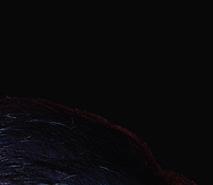
Shira Friedman-Parks,


Shira Friedman-Parks,
03 Reader Bites | Collo-Julin El Vurrito at Ahuevo
& POLITICS
04 Schools Chicago Board of Education discusses a proposed budget for CPS.
06 Make It Make Sense | Mulcahy Illinois leaders rebuke Trump’s National Guard threats, Trump targets states with cashless bail policies, and a new legal hotline for LGBTQ+ people
07 Immigration ICE should not be making agreements with local police departments.
08 Cover Story | Friedman-Parks Photographer Justin Jones’s glamorous snapshots of the darkwave scene
10 Preview | Reid Kimberly Dixon-May’s Rabbits in Their Pockets at Lifeline uses African American folktales to tell a contemporary family story.
12 The Moviegoer Acts of absurdity
12 Movies of Note Americana is unlikely to be remembered, Boys Go to Jupiter is cute and charming, Honey Don’t! is a damn good time at the movies, and more.
14 Chicagoans of Note | Brown Law Mahone, founder of Triptych Visuals
16 The Secret History of Chicago Music Stadium organist Nancy Faust transformed the sound of baseball.
18 Shows of Note Previews of concerts including Gary Bartz & Ntu Troop at the Chicago Jazz Festival, the Extra Shi Show, and ARC Music Festival
22 Gossip Wolf Cybergrinders Blind Equation change a key variable on A Funeral in Purgatory, Ambient Chess returns to Sleeping Village, and more.
23 Jobs 23 Services
(Clockwise from top)
Still from Boys Go to Jupiter (2025)

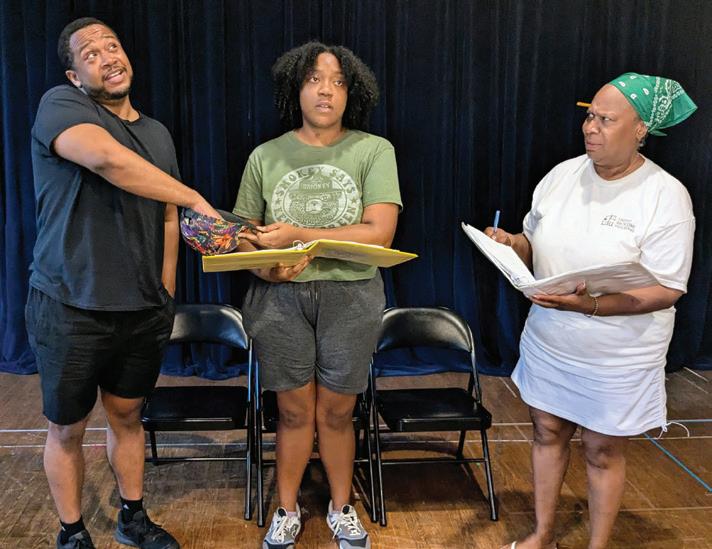

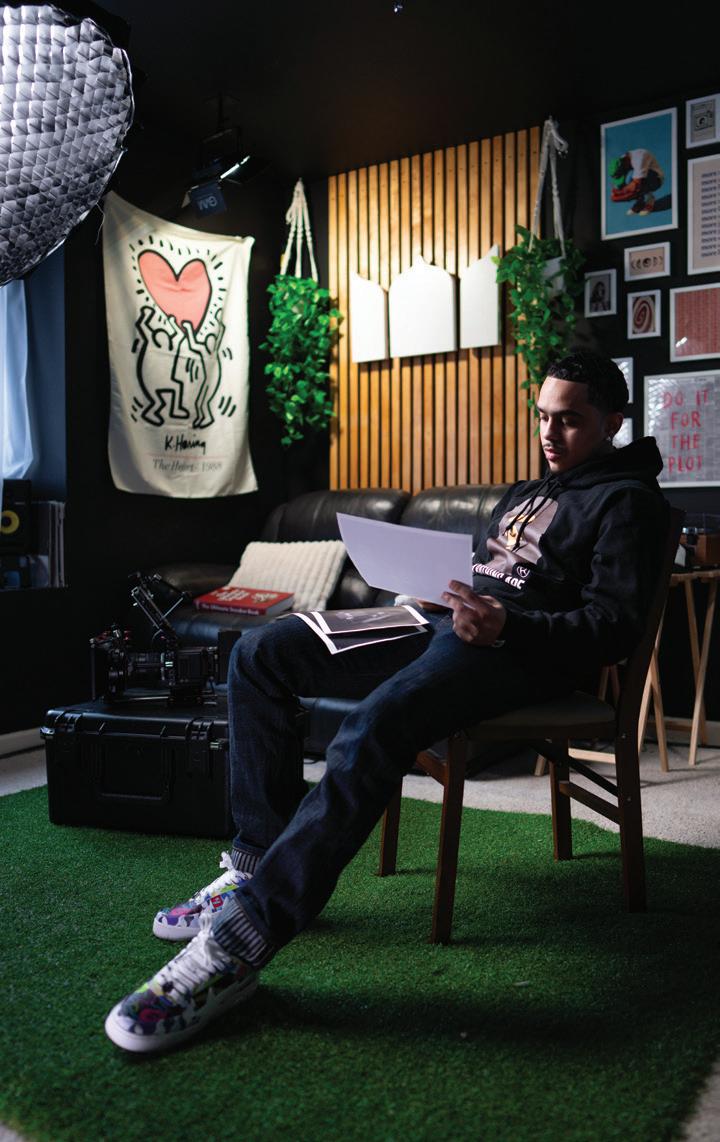
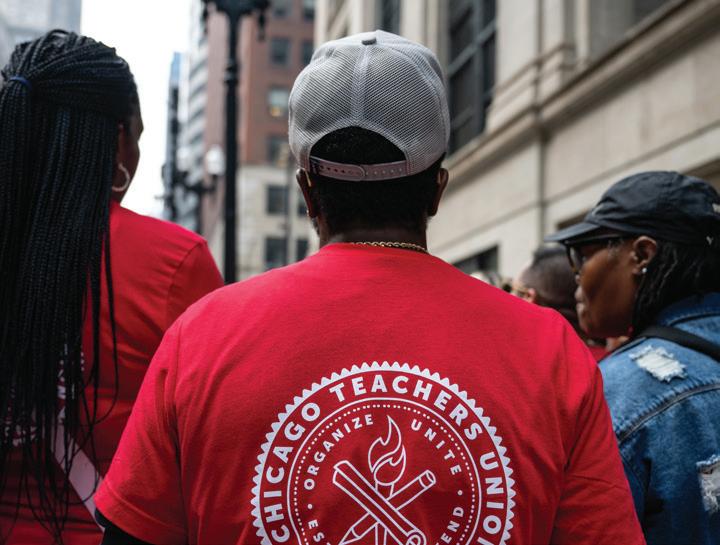
Audience members in between sets
INTERIM PUBLISHER ROB CROCKER
DIRECTOR OF ADVERTISING AND REVENUE
PRODUCTS AMBER NETTLES
CHIEF OF STAFF ELLEN KAULIG
EDITOR IN CHIEF SALEM COLLO-JULIN
ASSISTANT MANAGING EDITOR
SAVANNAH RAY HUGUELEY
PRODUCTION MANAGER AND STAFF
PHOTOGRAPHER KIRK WILLIAMSON
SENIOR GRAPHIC DESIGNER AMBER HUFF
GRAPHIC DESIGNER AND PHOTO RESEARCHER SHIRA FRIEDMAN-PARKS
THEATER AND DANCE EDITOR KERRY REID MUSIC EDITOR PHILIP MONTORO
CULTURE EDITOR: FILM, MEDIA, FOOD AND DRINK TARYN MCFADDEN
CULTURE EDITOR: ART, ARCHITECTURE, BOOKS KERRY CARDOZA
NEWS EDITOR SHAWN MULCAHY
PROJECTS EDITOR JAMIE LUDWIG
DIGITAL EDITOR TYRA NICOLE TRICHE
SENIOR WRITERS LEOR GALIL, DEANNA ISAACS, BEN JORAVSKY, MIKE SULA
FEATURES WRITER KATIE PROUT
SOCIAL JUSTICE REPORTER DEVYN-MARSHALL BROWN (DMB)
STAFF WRITER MICCO CAPORALE
MULTIMEDIA CONTENT PRODUCER SHAWNEE DAY
SOCIAL MEDIA ENGAGEMENT
ASSOCIATE CHARLI RENKEN
VICE PRESIDENT OF PEOPLE AND CULTURE ALIA GRAHAM
DEVELOPMENT MANAGER JOEY MANDEVILLE DATA ASSOCIATE TATIANA PEREZ
MARKETING ASSOCIATE MAJA STACHNIK
MARKETING ASSOCIATE MICHAEL THOMPSON
SALES REPRESENTATIVE WILL ROGERS
SALES REPRESENTATIVE KELLY BRAUN
SALES REPRESENTATIVE VANESSA FLEMING
ADVERTISING
ADS@CHICAGOREADER.COM, 312-392-2970
CREATE A CLASSIFIED AD LISTING AT CLASSIFIEDS.CHICAGOREADER.COM
DISTRIBUTION CONCERNS
DISTRIBUTIONISSUES@CHICAGOREADER.COM
READER INSTITUTE FOR COMMUNITY JOURNALISM, INC.
CHAIRPERSON EILEEN RHODES
TREASURER TIMO MARTINEZ
SECRETARY TORRENCE GARDNER
DIRECTORS MONIQUE BRINKMAN-HILL, JULIETTE BUFORD, DANIEL DEVER, MATT DOUBLEDAY, JAKE MIKVA, ROBERT REITER, MARILYNN RUBIO, CHRISTINA CRAWFORD STEED
READER (ISSN 1096-6919) IS
COPYRIGHT © 2025



Why do people love going out for breakfast so much? It seems like a scam: Eggs are one of the only things that the non-cooks among us can actually cook without much trouble, and most of the breakfast ingredients are on the cheaper end of food costs for restaurants. For me, it’s the luxury of starting a day (early riser diner, midafternoon leisurely bruncher, I don’t care) with someone else bringing me a little bit of sunshine in the form of eggs and coffee. My friend Ann told me her theory is that sleeping is usually our biggest fasting time, so when you go into a place with bacon and co ee wafting in the air, perhaps feeling excited to meet up with your friends, the combination of sensations opens up your pleasure centers. Your body is crawling out of the death of sleep, and delicious smells and the anticipation of happiness are conspiring to make you feel wonderful.
their own freestanding location later this year and have already started renovating a space at 520 W. Harrison. But for now, you can order Ahuevo through the delivery apps or just show up at Mi Tierra and follow the sign.
Ahuevo has succeeded in convincing me that an all-vegan breakfast burrito is not only possible, but delicious. I’m an anything-eater, but I started moderating my meat intake a bit after giving it up for Lent this year. And Ahuevo’s El Vurrito got me through.

It’s a mix of scrambled faux eggs, vegan cheddar that does not have a waxy or nutty aftertaste (which is my problem with much of the vegan dairy landscape), tater tots, green onion, vegan spicy mayo made in-house, and a flour tortilla. I like to add vegan chorizo for a little more oomph, and they’ll also throw in avocado if you like. The tater tots are a great addition and give the whole thing a very satisfying crunch. It’s not complicated, but it will bring you joy. And that’s all any of us needs first thing in the morning.
Headed home from an early afternoon errand a few months ago, I realized I hadn’t eaten all day. I wasn’t really in the mood for lunch, but I passed Mi Tierra in Little Village, a longtime staple with reliable lunch fajitas. When I walked in, there was something new: a sign that read “Ahuevo!” with an arrow pointing toward a short menu.
Ahuevo is a breakfast-and-lunch-only outfit that has been using part of Mi Tierra’s kitchen and dining area since the summer of 2023. They’re planning to expand to
“Ahuevo” literally translates to “an egg,” but it also works as slang in some regional Mexican Spanish. The slang meaning varies depending on who you’re talking to, but the positive version is something akin to “Absolutely,” or “Hell yes!” which is how I feel after an El Vurrito. —SALEM COLLOJULIN AHUEVO 2528 S. Kedzie, Mi Tierra Restaurant, $12.99–$18.99, 224-809-7416, ahuevo.com v
Reader Bites celebrates dishes, drinks, and atmospheres from the Chicagoland food scene. Have you had a recent food or drink experience that you can’t stop thinking about? Share it with us at fooddrink@ chicagoreader.com.

The Reader has updated the online version of the story “Dance against war,” written by Wendy Wei and originally published in our August 21 issue (volume 54, number 46).
The print version neglected to mention that Wei’s reporting was supported by the International Women’s Media Foundation’s Women on the Ground: Reporting from Ukraine’s Unseen Frontlines initiative, in partnership with the Howard G. Buffett Foundation. Additionally, Tetiana Burianova contributed reporting for the story. v




Find us on socials: facebook.com/chicagoreader twitter.com/Chicago_Reader instagram.com/chicago_reader linkedin.com search chicago-reader
The Chicago Reader accepts comments and letters to the editor of less than 400 words for publication consideration. m letters@chicagoreader.com
By MAUREEN KELLEHER
Last week, during hearings on the Chicago Public Schools 2026 budget, Alderperson
Nicholas Sposato o ered Chicago Public Schools Interim CEO/Superintendent Macquline King an apology: “Dr. King, I just want to say to you personally, I had you all wrong. I was 100 percent wrong about you, and you’ve been a pleasant surprise to me.”
King surprised Sposato and many others by presenting a 2026 budget that made paying $175 million to the Municipal Employees’ Annuity and Benefit Fund of Chicago, or MEABF, contingent on receiving more money from the city, the state, or both. The school board will vote on the budget on August 28, one day before state law requires they have a balanced budget in place. Previous Chicago school boards have approved budgets without question, but this year, board approval is not assured.
King’s budget fills a $734 million deficit without borrowing, requiring unpaid furlough days, or laying o teachers. It also assumes the city will declare a surplus of tax increment financing (TIF) district funds as large as it did in 2025: a record-breaking $712 million. Thanks to a formula that ensures CPS gets a bit more than half of any TIF surplus, this year the school district received $379 million.
King’s decision to make the pension payment conditional on new revenue has split the board. As of last Friday, nine elected members supported the proposed budget; ten members—nine mayor-appointed plus elected member Aaron “Jitu” Brown—wanted it tweaked to include the pension payment and make borrowing an option. Board president Sean Harden also wanted the change, but he
“In order to solve our own budget, we need to take out a TIF surplus. Anyone who tells you we’re going to withhold TIF is lying to you.”
–Alderperson Andre Vasquez


Interim superintendent Macquline King offered plan to make the pension payment conditional on new revenue
only votes in the case of a tie. There is one vacancy due to the recent resignation of appointed member Frank Niles Thomas.
For more than a year, Mayor Brandon Johnson and the school district have been arguing over the MEABF pension payment, which CPS began making in 2020 under pressure from
which have been deeply intertwined since Chicago’s public schools were first created. Back in December, the last fully appointed school board fired former CEO Pedro Martinez after he refused to take out a loan to make the city pension payment. In March, an e ort by appointed board members to amend the budget to include the payment never came to a vote, likely because enough elected board members opposed the move to block the
members who want the budget tweaked argue that the city might not declare another large TIF surplus again without a guarantee that CPS will make the payment this year. They prefer to pay toward the city pension while pressuring the state into delivering more money for all schools by increasing taxes on Illinois’s wealthiest residents. And if they have to borrow to make ends meet in the meantime, so be it.
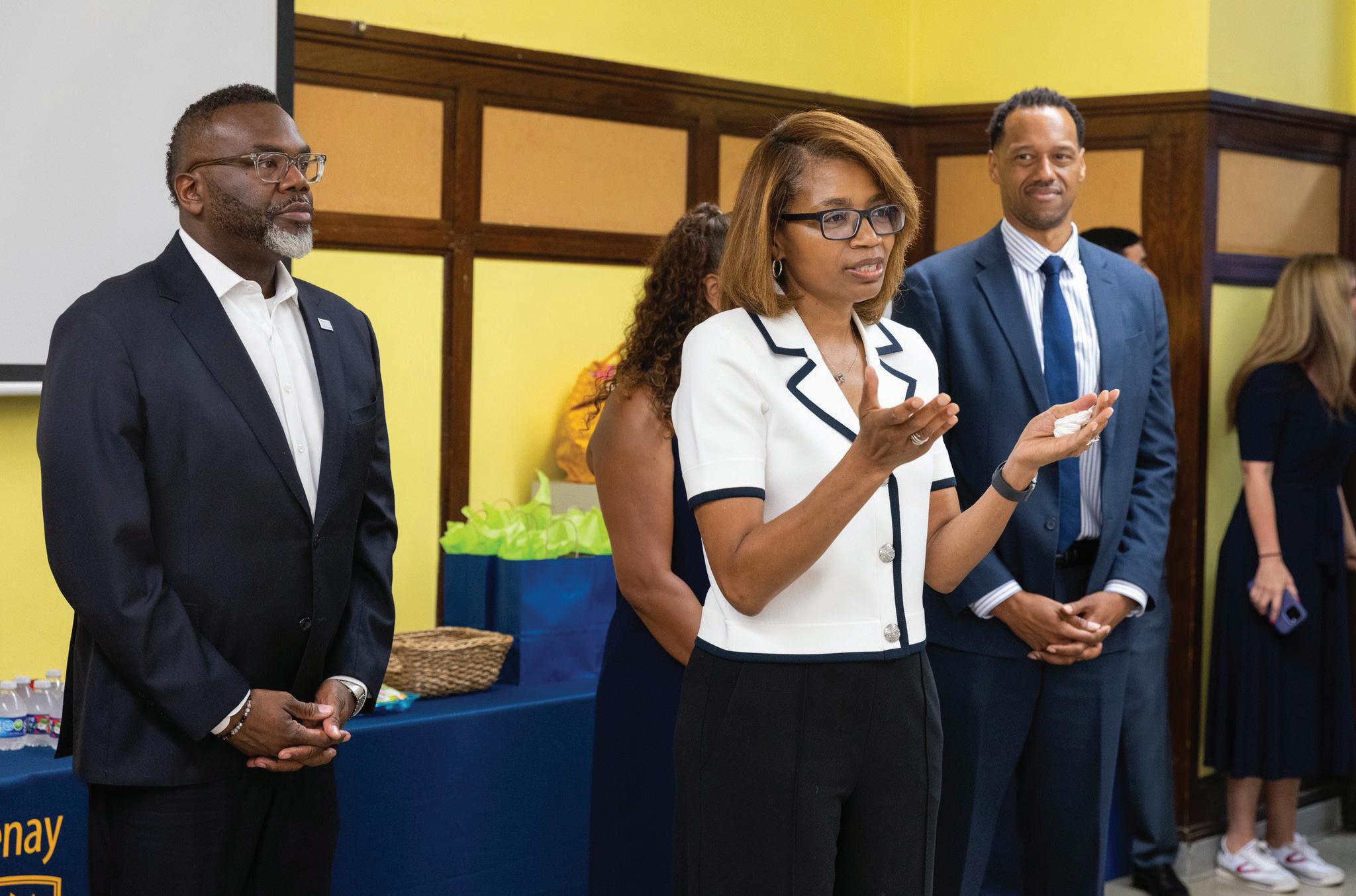
Dr. Macquline King speaks at the fi rst day of the 2025-2026 school year, alongside Mayor Brandon
former mayor Lori Lightfoot. State law says funding this pension is only the city’s responsibility. But as the Chicago Board of Education exits mayoral control, both the city and the school board want to separate their finances,
two-thirds majority needed. Many observers expected King to put this payment in the 2026 budget without conditions, since Johnson favored her to serve as interim. But she didn’t.
The slim majority of mayor-allied board
and
“We are fighting for state funding, and we’re not going to stop fighting for it,” board member Emma Lozano said during the budget hearings. “I have confidence we’re going to get it, and once we get it, we can pay back the loan.”
Supporters of the budget as presented counter that filling the city’s own budget hole will require a TIF surplus, and borrowing for the pension payment risks downgrades to the school district’s credit rating. Since the 2010s, the school district has been the nation’s largest junk bond issuer, though its credit has seen some upgrades in recent years.
While everyone agrees additional state money for schools must be part of the longterm solution to the CPS budget troubles, Gov-
“It is my understanding that the city has moved away from using TIF surplus as a means of balancing the budget,” board president Harden said during the budget hearings.
“In order to solve our own budget, we need to take out a TIF surplus. Anyone who tells you we’re going to withhold TIF is lying to you,” countered Alderperson Andre Vasquez.
within the boundaries of the TIF district. Between 2014 and 2024, the amount of money in Chicago’s TIF districts more than doubled to $3.2 billion.
State law says that local governments should annually calculate the amount of money in their TIFs that is not committed to development projects and surplus it—returning it to all the agencies that receive property taxes, including CPS. City policy spells out how to decide which TIFs to surplus and how

ernor J.B. Pritzker has repeatedly said more school funding won’t happen in the immediate future.
In the long run, said Joe Ferguson, president of the government fiscal watchdog Civic Federation, someone—likely the state—will need to determine not just the city and the school district’s responsibility for MEABF payments, but give CPS the ability to raise taxes to pay it, too. “No one’s had a conversation about levy authority, how you actually fund it,” Ferguson said. “Both of those things have to go together.”
History suggests Vasquez has a point. The city has declared a TIF surplus annually for the last 15 years, beginning in the wake of a Reader investigation into the use of these special taxing districts as a “shadow budget” for mayors and alderpeople to fund pet construction projects.
When the City of Chicago creates a TIF district, the amount of property tax the area generates is frozen for 23 years. As property values in the area increase, the property taxes generated by the increased value go into a special fund for development projects
the knees,” he said. This would create problems for Cook County board president Toni Preckwinkle, who is also the chair of the Cook County Democratic Party.
“We are fighting for state funding, and we’re not going to stop fighting for it.”
–board member Emma Lozano
Ferguson suggested throwing off Cook County’s finances could spell political trouble for the City Council. “Who heads the county?
The person who decides who is slated for reelection for every one of these aldermen,” he noted.
Meanwhile, getting money from Springfield for schools appears to be a longer-term project. Last week, Governor Pritzker signaled that there might be room in the fall legislative session to work out a financial solution for the budget crisis in public transit, but firmly shut the door on more money for schools. “What CTU and the mayor are talking about—which is providing another $1 billion or $1.6 billion for Chicago Public Schools—that’s just not gonna happen,” he told reporters.
All this leaves Chicago’s school board politicking among each other behind the scenes. After joining ten other members in a letter asking King and her budget team to include the payment and an option for borrowing, elected board member Ebony DeBerry now supports the budget as presented. “The budget looks good as is,” she said. She’s confident in the budget assumption regarding TIF surplus. “There is a formula that is very generous toward the board.”
much money to sweep, but state law says the swept funds must be distributed in proportion to the percentage of property taxes each agency collects. For CPS, that is about 52 percent, compared with 23 percent for the city. So if the city declares a TIF surplus, CPS will get more than twice as much of the money as the city itself.
Other taxing bodies also are relying on Chicago TIF surplus funds to make their budgets work, including Cook County, said Ferguson, the budget watchdog. Not declaring a TIF surplus in 2026 “would cut the county o at
There’s also external pressure both ways on board members, notably from digital ads paid for by both CTU and the Common Ground Collective, a dark money group that has paid for ads attacking Johnson’s allies on City Council.
Whatever else happens, DeBerry hopes she and her colleagues can stay united enough to shield classrooms from deep cuts. “I’m just hoping we do what we plan to do, keeping cuts away from classrooms,” she said. “We know a lot of our children are more expensive to educate: immigrants, poor children, children who are di erently abled. We need a budget that demands justice for all of them.” v
m letters@chicagoreader.com
RILLINOIS PRIDE CONNECT
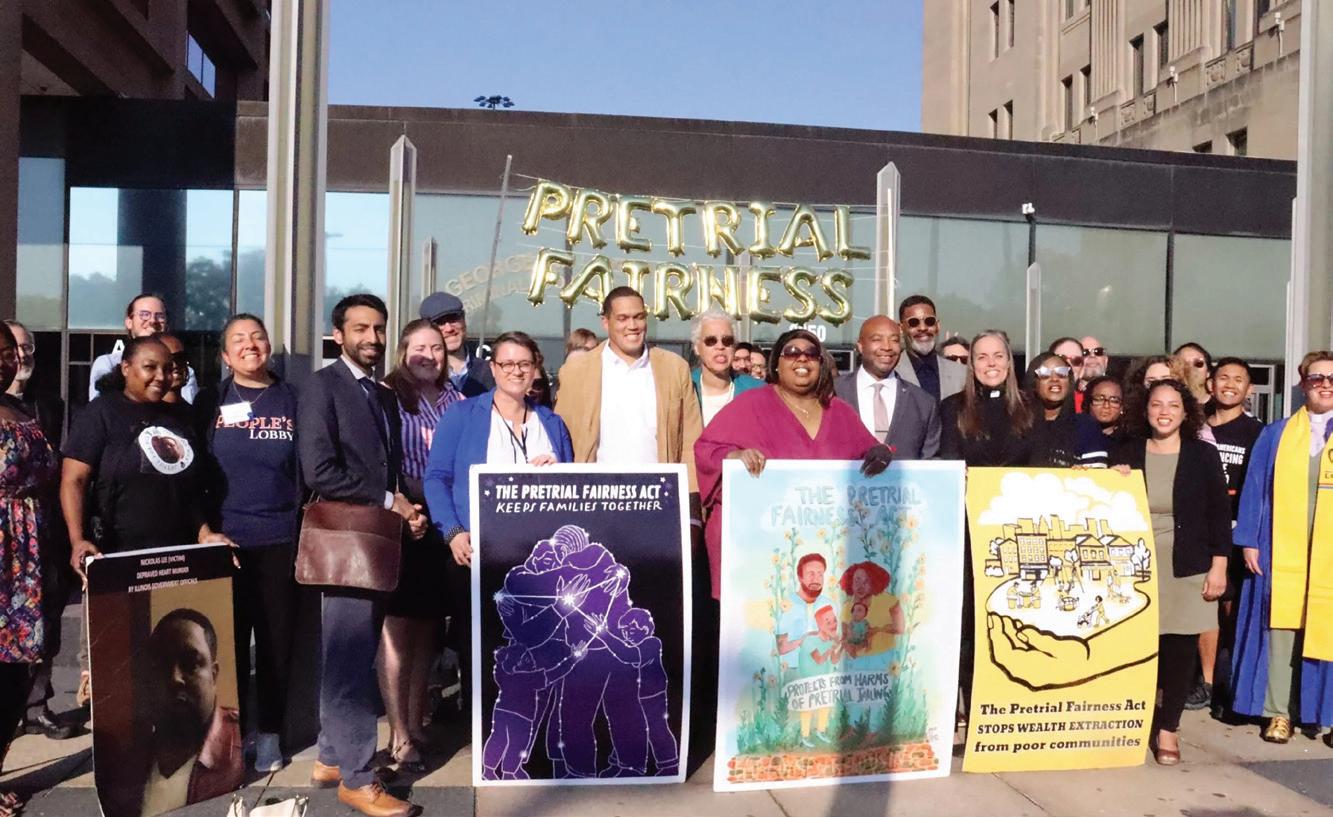

“Mr. President, do not come.”
Dozens of state, city, community, and business leaders joined together on Monday to deliver a unified message to President Donald Trump: Stay out of Chicago.
On August 22, Trump suggested he would attempt to deploy troops from the Illinois National Guard to Chicago. A day later, the Washington Post reported that the Pentagon had been planning such an invasion for weeks—one that could see a few thousand National Guard and active-duty soldiers patrolling the city’s streets as soon as Labor Day weekend.
Illinois politicians and community leaders slammed the idea as a “political power grab” and warned of legal challenges and protests should Trump follow through on his threats. “Mr. President, do not come to Chicago,” said Governor J.B. Pritzker . “You are neither

wanted here nor needed here.”
Pritzker was joined by, among many others, Mayor Brandon Johnson , Illinois attorney general Kwame Raoul, U.S. senators Dick Durbin and Tammy Duckworth , U.S. representatives Delia Ramirez and Jesús “Chuy” García, Chicago CRED’s Arne Duncan, and Saint Sabina priest Michael Pfleger for a riverfront press conference in the Loop.
Meanwhile Trump wavered on whether he’d go through with the invasion when pressed by reporters in the Oval O ce on Monday. “We may or may not. We may just go in and do it, which is probably what we should do,” Trump said. “You know, I hate to barge in on a city and then be treated horribly by corrupt politicians and bad politicians, like a guy like Pritzker.”
Trump on Monday also ordered the U.S. Department of Defense to create “specialized” National Guard teams in all 50 states and D.C. that can mobilize rapidly to quash dissent.
President Trump on Monday signed an executive order threatening to withhold federal funding from state and local governments that have abolished money bond.
In response, Illinois lawmakers and advocates who led the charge to eliminate cash bail in the state through the Pretrial Fairness Act warned that withholding federal money would only harm communities.
“We want to be very clear: The president’s attack on the Pretrial Fairness Act and pretrial reforms nationwide is not about safety,” said state senators Elgie Sims Jr. and Robert Peters and state representative Justin Slaughter in a joint statement. “He is a deeply unpopular, failing president who is trying to make people afraid so that he can hold onto power by brute force.”
In 2023, Illinois became the first state to
Mon-Thu 9 AM- 4 PM, free legal hotline for LGBTQ+ people, available in English and Spanish, 855 - 805 -9200, ilprideconnect.org
entirely eliminate cash bail. Where, traditionally, people accused of crimes would be required to pay a sum of money to be released from jail before their trials, Illinois and other jurisdictions—like Washington, D.C., New Jersey, New Mexico, and Washington—allow people to await their trials at home without paying any money.
A 2024 study from Loyola University Chicago’s Center for Criminal Justice found that, contrary to Trump’s claims, crime did not increase in the year after Illinois eliminated money bond. In some counties, crime actually decreased.
“Flooding communities with masked agents and threatening one of our state’s most effective civil rights achievements, passed after years of advocacy from communities across the state, is the hallmark of a leader who cares only about his own power,” said the advocacy group Illinois Network for Pretrial Justice in a statement. “The Pretrial Fairness Act has made Illinois safer and eliminated a system that privileged the wealthy.”
In Chicago and nationwide, violent crime has dropped dramatically in recent months.
A new legal hotline and resource hub launched in early August to serve LGBTQ+ people in Illinois with questions about health care, school and education rights, immigration, government records, family protection, and more. Illinois Pride Connect was created by the Legal Council for Health Justice, with support from the Illinois Department of Human Services and private donors. The free legal hotline at 855-805-9200 is available in both English and Spanish and is sta ed with attorneys and legal advocates from 9 AM to 4 PM Monday through Thursday.
The organization o ers confidential support and referrals for concerns related to gendera rming care, discrimination, public benefits, housing, safety concerns, and similar legal issues.
Illinois Pride Connect doesn’t provide ongoing representation, but representatives can offer onetime legal advice to anyone in Illinois and will refer hotline callers to other legal partners throughout the state.
—SHAWN MULCAHY v
Make It Make Sense is a weekly column about what’s happening and why it matters.
m smulcahy@chicagoreader.com
Agreements between ICE and local police are eroding public safety and trust in law enforcement.
By MAYA KHADR, OTHERWORDS
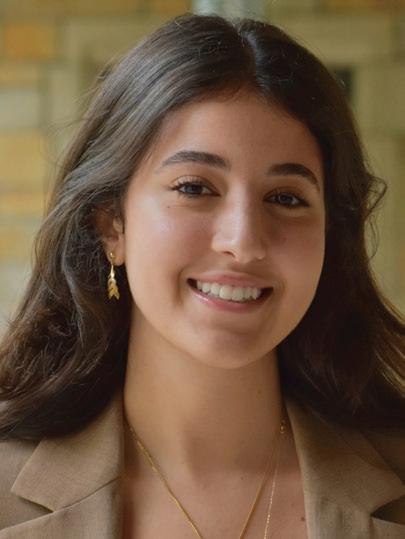
This spring, a 19-yearold university student named Ximena Arias-Cristobal was sent to an immigrant detention center in Dalton, Georgia, for an alleged traffic violation. The traffic charges were eventually dropped, but it was too late. Authorities in Dalton had already called Immigration and Customs Enforcement (ICE) under a federal program that turns police encounters into deportation pipelines.
With her final exams approaching and her family’s future depending on her academic success, Arias-Cristobal was detained in a privately run detention center notorious for inhumane conditions and severe rights violations.
Unfortunately, her story is not an isolated incident. It’s part of a broader reality across the country as local police departments become extensions of federal immigration enforcement through what are called 287(g) agreements.
That refers to Section 287(g) of the 1996 Illegal Immigration Reform and Immigrant Responsibility Act. The program authorizes ICE to train and deputize state and local law enforcement to carry out immigration duties, effectively turning police o cers into ICE agents while conducting their routine police work. This program perpetuates racial profiling and other civil and human rights abuses, and the Trump administration is leading a big push to expand it. Since the beginning of the second Trump administration, there’s been a 566 percent increase in 287(g) agreements, with 765 new agreements signed nationwide as of mid-August.
These agreements are generally limited to
certain cities, counties, or state agencies. But states like Florida and Georgia have passed laws requiring all counties in their states to
participate in 287(g). Florida governor Ron DeSantis even pushed universities to sign agreements that turn college campuses into targets of mass deportation. Apparently no space is safe for immigrant communities.
This program is eroding public safety and trust in law enforcement. When people fear that dialing 911 could result in the deportation of themselves or a loved one, crimes go unreported, victims stay silent, and witnesses refuse to cooperate with criminal investigations.
A 2018 study by the Cato Institute found no evidence that these partnerships with ICE decreased crime rates. They simply made
communities less safe for everyone.
Expanding 287(g) agreements normalizes racial profiling and discrimination. That led President Barack Obama to scale back the program in 2012 after repeated instances of constitutional abuses in Maricopa County, Arizona, yet it’s been resurrected under Trump and is now growing exponentially.
And so are the abuses.
Jose Alvaro was buying baby formula when he was arrested in Lubbock, Texas, after police pulled him over for a license plate issue and called ICE. Despite having no criminal record, Alvaro was kept in immigration detention, leaving his wife and three children alone.

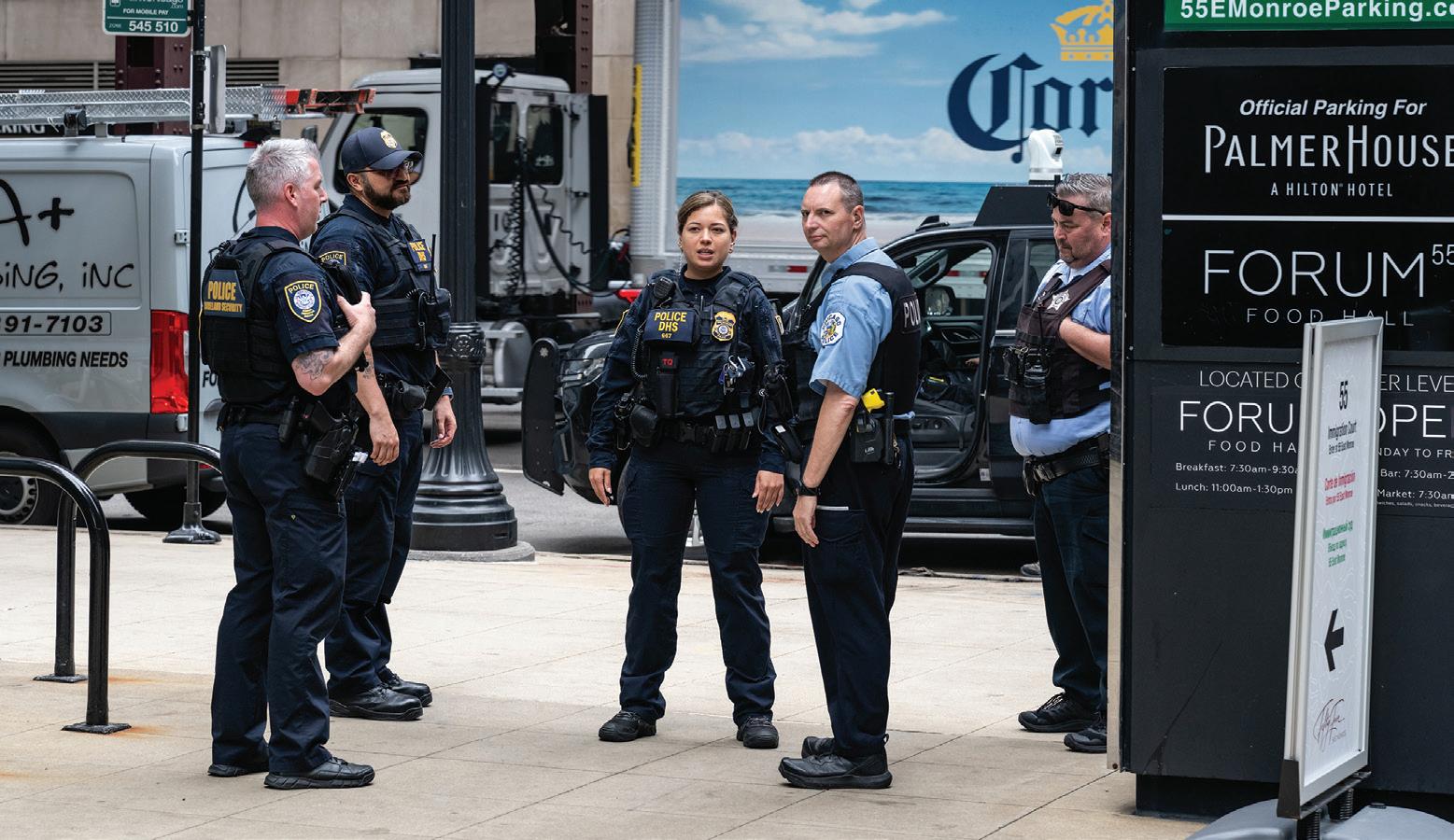
Despite the administration’s claim that it’s focusing on deporting “criminals,” stories like Alvaro’s and Arias-Cristobal’s are no exception. In one recent study, 71.5 percent of the 57,000 immigrants in ICE custody had no criminal convictions.
It’s clear these agreements are making our communities less safe. But other states are fighting back. California, Oregon, Washington, Illinois, New Jersey, and Colorado provide blueprints for resisting this program statewide. They’ve already passed laws restricting local cooperation with ICE, outlawing 287(g) in all counties.
Other state lawmakers must follow their lead and refuse to turn their communities into hunting grounds for vile immigration policies. Local o cials can also do their part to reject 287(g) agreements, prioritizing community safety over deportation quotas.
We can also pressure universities and institutions to reject pressure to implement these agreements. The Immigrant Legal Resource Center (ILRC.org) provides a tool kit to mobilize against expanding ICE authority and a map of agreements across the country. Call your representatives and local police, and talk to your friends and family. Together we can protect our immigrant neighbors—and make our communities safer for everyone.
Maya Khadr is a Henry A. Wallace Fellow at the Institute for Policy Studies. This op-ed was distributed by otherwords.org. v
m letters@chicagoreader.com

By SHIRA FRIEDMAN-PARKS
Photographer Justin Jones chases the in-between moments of emotion, one darkwave show at a time. Fascinated by the ability of intense stage performance to reveal one’s essence, Jones attends music, theater, and dance shows alike. “I’m looking for people in the middle of something,” he said. “I’m looking for expressions that are absorbed.”
In Jones’s black-and-white photos, we catch glittering chains, ripped tights, sharp eyeliner. Faces are poised in focus—mouths agape, mikes gripped. Streaks of light shine through veils and corsets, wings and horns. They’re glamorous, serene snapshots that simultaneously emulate the high-energy performances they’re pulling from.
Jones moved to Chicago in 2014 to pursue an MFA in documentary filmmaking from DePaul University. Photography was his side project. “I had an analog camera that my grandpa gave me. I’d take pictures of friends, patterns, colors.” Inspired by the stillnessfocused American photographers William
Eggleston and Todd Hido, Jones was drawn to atmosphere and landscapes. Shifting between color and gray scale, he documented the grids of construction scenes, the glow of neon signs, and the shadows of train stations.
In 2017, Chicago filmmaker Laurie Little invited him to codirect a short documentary of an old friend, French rock ’n’ roll photographer Richard Bellia. Little hails from Quebec’s 80s punk scene; “she was throwing warehouse raves in Canada before we were born,” Jones quipped. Bellia came over to Carbondale, Illinois, to witness the total eclipse with his daughter. Little and Jones joined him, and Jones and the photographer clicked. What began as a short documentary (eventually released in 2019) evolved into a long-term friendship and mentorship, and a feature-length portrait documentary spanning eight years.
A year later, Jones landed in Paris to screen a short at the Ethnografilm festival. Bellia invited him to come stay with him in Lyon. Jones filmed Bellia; Bellia taught Jones darkroom

printing. “On the one hand, I’m a filmmaker; on the other, I’m an apprentice,” Jones said. There, Jones fell in love with Bellia’s blackand-white performance portraiture, windows into big figures’ small moments. Robert Smith’s silhouetted rat’s nest gleams against the light. Kim Gordon grins. Axl Rose leans into a sea of hands. Siouxsie reapplies her lipstick.
Little and Jones continued to film Bellia
on and o for the next couple of years. They followed him as he photographed the Cure at Paris’s Rock en Seine, and then at Chicago’s United Center; at his exhibition with agnès b; with his family in France; teaching photography in a men’s prison; back in Carbondale for last year’s eclipse; back in France.
Isolated in 2021, Jones built a darkroom in his apartment. With the Bellia documentary on hiatus, he dedicated himself more seri-

ously to photography. In the following years, he started going to more shows, becoming more drawn to capturing human expression. “There’s something beautiful when a performer is in it,” he said. “Film photography, especially, is spiritual. Getting somebody doing what they’re best at is the easiest way to capture their essence.”
Jones works as a photographer for Sanctum and Theatre Y—the latter of which is the sub-


ject of his current documentary project—taking on the occasional cinematography or editing job. For the most part, he just brings his camera along to the shows he’s already going to. “I like darkwave. It’s a good time. The musicians are great. The scene is good-natured.” His photos bounce from the Empty Bottle to Sleeping Village to a highway underpass, documenting the likes of Stress Positions, Fantasma Negra, and Insula Iscariot.
Jones’s photography work is heavily influenced by his training as a documentary filmmaker. In both mediums, he prefers to capture moments as they happen rather than craft posed scenes. When I asked if he found a throughline between his past and present photography work, given the shift in approach and content, he told me it was the spark he feels in the moment. He referenced 20th-century French photographer
Henri Cartier-Bresson’s term “the decisive moment,” a distinctive snapshot in time. “When your eye responds to a moment, it says something not only about the composition and the beauty of the moment, but about you, because you responded to it,” he said. “Part of what I’m looking for is a touch of the mystical.” v
sfriedman-parks@chicagoreader.com
RABBITS IN THEIR POCKETS
9/5 -10/5 : Fri 7:30 PM, Sat 2:30 and 7:30 PM, Sun 2:30 PM; Sat 9/6 and 9/ 13 7:30 PM only; Lifeline Theatre, 6912 N. Glenwood, 773 -761- 4477, lifelinetheatre.com, $ 45 ($ 30 previews 9/5 -9/ 13 )
Kimberly Dixon-Mays’s contemporary play about sisters and resilience draws inspiration from African American folktales.
By KERRY REID
For most of its 43 years, Lifeline Theatre in Rogers Park has focused on literary adaptations, ranging from 19th-century classics by writers such as Jane Austen and Wilkie Collins to detective stories by Dorothy Sayers and sci-fi/speculative fiction, alongside their parallel KidSeries of shows for young audiences. Their most recent production, ensemble member John Hildreth’s adaptation of H.G. Wells’s The War of the Worlds, gave the 1890s novel a contemporary Chicago setting. But to kick o their new season, the company has found a di erent approach to adaptation by honoring folktales and the oral tradition rather than a published novel, while also giving a Chicago writer the world premiere of her first full production.
Drawing in part on the African American trickster tales of Br’er (or Brother) Rabbit, Kimberly Dixon-Mays’s Rabbits in Their Pockets is also a wholly original Chicago-set family drama about two sisters, Ash and Harley, who have been (passively) semi-estranged. The two women come together to fix up their parents’ old house on the south side. Ash is literally a rocket scientist, and Harley harbors dreams of opening up a community arts center with an emphasis on improvisation. But Ash’s design plans for the home, as well as a mysterious maybe-benefactor, Inola, add a touch of something beyond an everyday tale of adult sibling tension.

The play (directed by Christopher Wayland) grew out of Lifeline’s 2024 BIPOC Developmental Workshop, a program that began under former artistic director ILesa Duncan. Duncan departed that role last fall (she remains a member of the ensemble) as part of a restructuring designed to help the company overcome a $200,000 budget deficit, caused in part by the challenges faced by so many companies in returning after the 2020 COVID-19 shutdown. As Duncan told me earlier in 2024, “Before the pandemic, we wanted to expand the stories and expand who’s in the ensemble. We’re always looking for new voices to be involved because when you get to a certain age, then life changes, you know? So you still need an infusion of new voices and new blood in the company.”
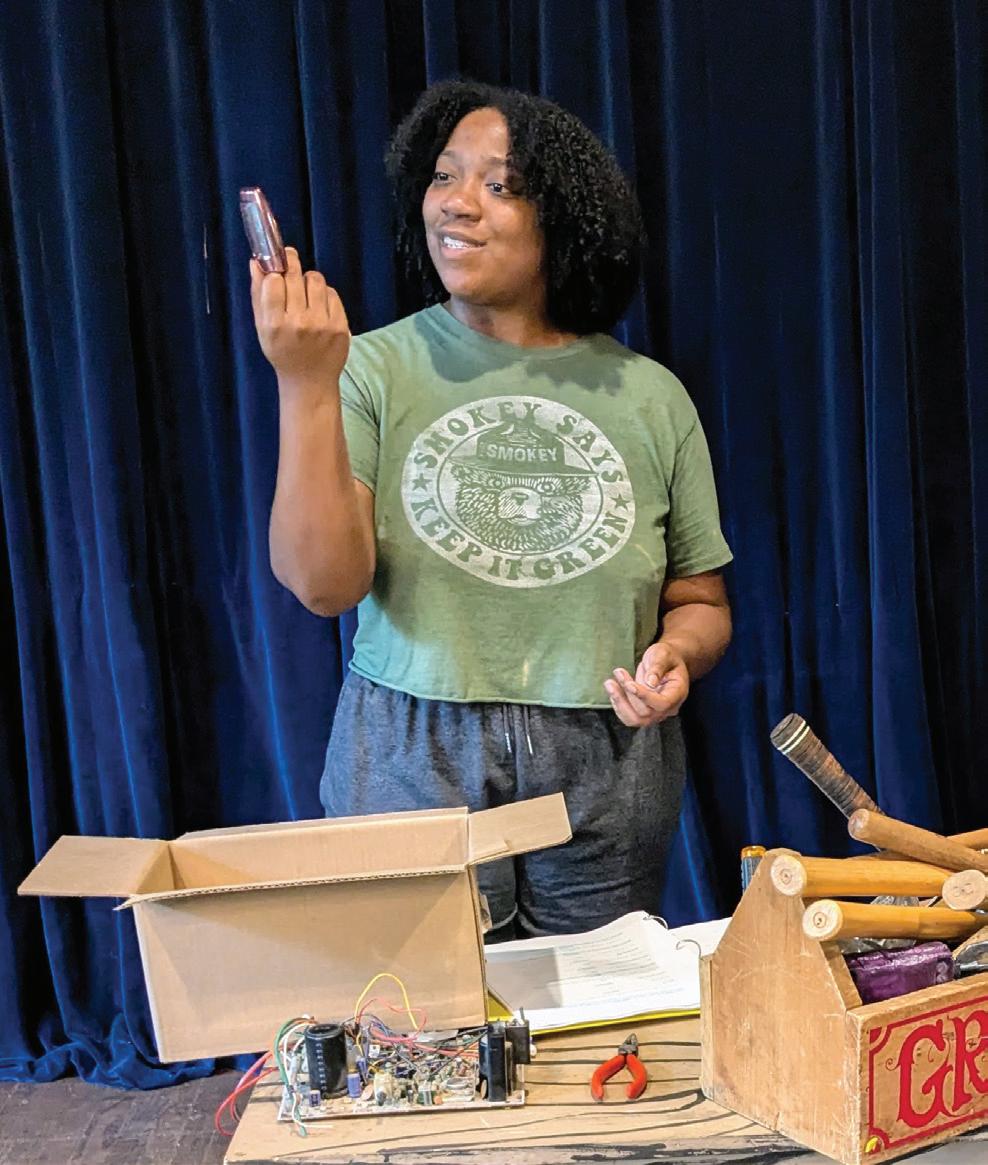
Dixon-Mays is a poet and playwright who has been involved in many prestigious developmental playwriting programs, including Goodman’s 2022 Future Labs series and Congo Square Theatre Company’s 2019 August Wilson New Play Initiative. (Her play for Congo Square, Nine , was also a semifinalist for the 2019 Eugene O’Neill National Playwrights Conference.) But making a connection with Duncan made the di erence in moving from page to stage.
“I had come to know ILesa sort of professionally as an acquaintance, and she actually directed a reading that I did with Congo Square,” says Dixon-Mays. “And so that was where I got to know her better. I saw the posting for the [BIPOC] program, and I, of course, knew of Lifeline and really admired the work they did. And I checked my notes, and I had like 36 hours to put a proposal together.”
One of the advantages of the Lifeline program, notes Dixon-Mays, was its long incubation and development process, including feedback from the ensemble. “I’ve been fortunate to have a variety of development experiences, from very short to something long. And there’s no match for having an ongoing conversation around a script and the level of trust that’s developed on both sides—the playwright trusting the person they’re talking with, and also that group trusting that the playwright has a vision and will deliver.”
Trust also plays a big role in Rabbits in Their Pockets, as the two sisters try to collaborate despite having very different sensibilities and lingering resentments over old family business. Ash’s vision for the home is that it will feed upon Black joy as a literal source of power. For her part, Harley proclaims that “improvisation is a Black technology—always
has been.” She also tells her friend and struggling fellow improviser, Jasper, that Br’er Rabbit is an improv hero. “You could tell he loved being the clever one. He was always coming up with something o the top of his head.”
Finding the relationship between Ash (LaKecia Harris) and Harley (Simmery Branch) was one of the key discoveries for Dixon-Mays in the Lifeline workshop process.
“I knew from day one that I wanted them to have some sort of intimate relationship where they knew each other quite well. But I did not know their genders, and I didn’t know the nature of their relationship. And so as I so often do, I had characters with names like X and Y. We read through a draft with only those names. And as people were talking about the scientist character, they kept slipping into ‘he, him.’ And I said to myself, ‘Well, I didn’t like that. What would happen if I chose to make both of the characters women?’ And then somewhere along the line, I decided for myself that I knew I didn’t want them to have a romantic relationship.”
Dixon-Mays notes that a key inspiration also came out of a trip she took to Martha’s Vineyard, which has had a vibrant Black community for centuries. “I was on a bike ride and I passed a house that said ‘Black Joy House.’ And I chose not to go in because it was just a sign, and I said, ‘I just want to believe whatever I want to believe about

what’s going on in that house.’ Part of my process is I have little things that strike my attention at different points, and then something prompts me to start knitting things together—like having 36 hours to put a proposal together.”
“My
I was in a trickster phase.”
other aspect of the folktales of Br’er Rabbit. He doesn’t just survive; he thrives.
“My intention was very much to write a play about resilience,” Dixon-Mays says. “I was in a trickster phase, meaning that I was really fascinated with trickster characters, in part because I was feeling an itch to expand the scope of what I had been writing about. I have always written stories about survivors, survivors of sort of existential threats, mean-
play about

There are plenty of in-jokes for Chicago improv aficionados sprinkled through the play as well, and Dixon-Mays notes that director Wayland has a background in improv. For Dixon-Mays, improvisation is also tied to an-
ing not ‘the tornado is coming’ or ‘that person has a gun,’ but ‘Who do I wanna be in this world and what is trying to prevent me from doing that?’ I was noticing that I was wanting to write plays in which people were wrestling
with that, and not just wrestling with it, but winning. I wanted some winning plays.”
As Ash notes at one point, “We’ve all got so many things to handle, just living our lives. It’s just a matter of time before there’s one thing too many, and it throws us o course. But we can’t a ord to get thrown o course.” So it’s perhaps appropriate that Dixon-Mays has reaped the rewards of staying on course as a writer and scored the win of a full production with a play about women striving to achieve their deepest dreams.
But what makes Rabbits stand out for me, at least from so many white-centered tales of sibling and family conflict (such as Tracy Letts’s August: Osage County), is that winning for Ash and Harley doesn’t depend on dominating or destroying another person.
Dixon-Mays says, “That’s the other piece of it—the importance of community and connection in pursuit of that joy and that pleasure and as a setting for that resilience. We can’t do it by ourselves.” v
m kreid@chicagoreader.com






Get showtimes and see reviews of everything playing this week at chicagoreader.com/movies
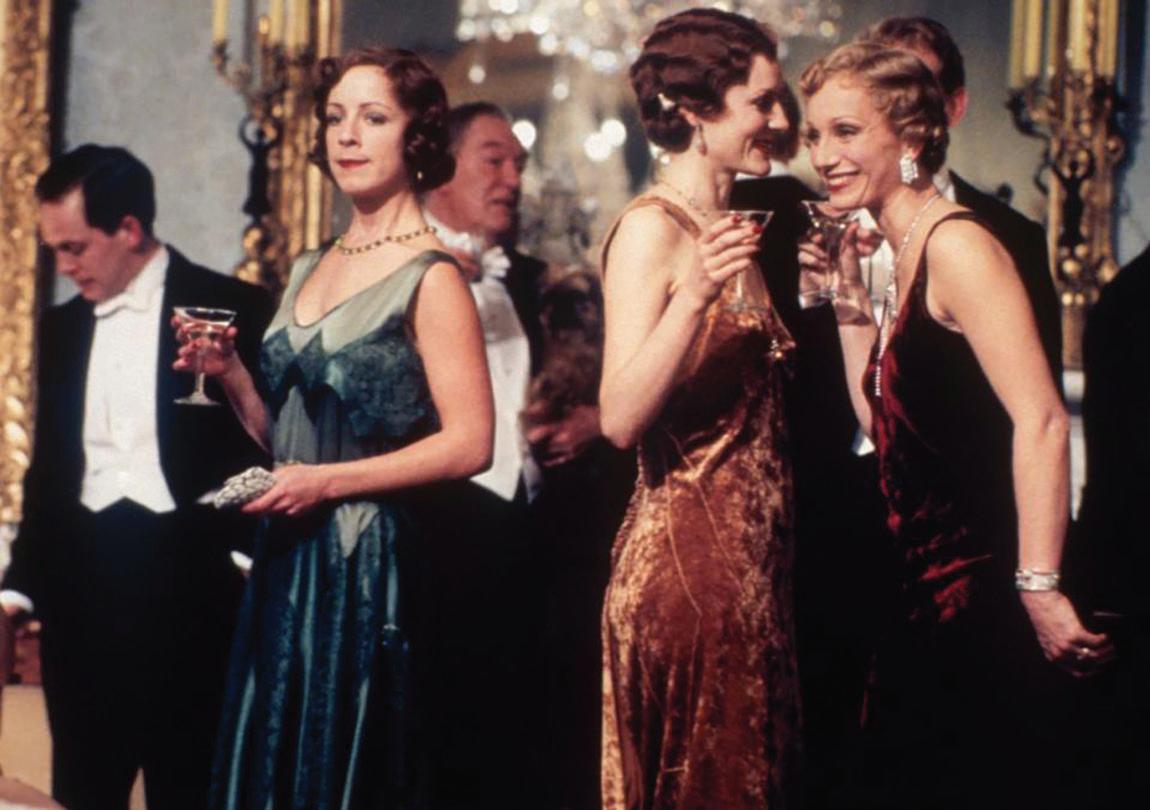




“The act of recording is an act of love.” That’s the title of a recent exhibition put on by the South Side Home Movie Project (SSHMP) at the Reva and David Logan Center for the Arts, which ended this past Sunday. (I interviewed SSHMP founder Jacqueline Stewart for the Reader several weeks ago.) It’s also something once remarked by singer, songwriter, and poet Jamila Woods on this material: “In these archival family videos, the act of recording is an act of love. To press record is to say, ‘I want to remember you, I wish you to be remembered.’”
Naturally, one hears “moviegoing” and thinks of a certain kind of moving-image experience, but thankfully, here in Chicago, home movies are a viable option. (For example, each year there’s a Home Movie Day; this year, the Chicago Film Archives and the Chicago Film Society will host Chicago Home Movie Day at the Chicago History Museum on November 1, where archivists and projectionists will inspect and project a selection of celluloid home movies in 16 mm, 8 mm, or Super 8 brought in by participants, with live accompaniment from pianist David Drazin.) This exhibit provided a beautiful overview of the SSHMP, one local organization that preserves home movies. My favorite parts were those that included some of the archives themselves. Every few days, a di erent family’s films screen in a room off the entrance to the exhibition; I sat for about a half hour awash in other people’s memories, enjoying the ebullient imagery and considering what lay beyond it.
Otherwise, it was a rather sporadic moviegoing week. First, I finally saw Akiva Scha er’s The Naked Gun (2025), which was hilarious, at the AMC River East. It certainly felt good to laugh and
Americana, the feature film debut of TV writer Tony Tost, begins in the plains of South Dakota and features several billboards, bumper stickers, and storefronts that let us know we’re in “cowboys and Indians” country. But more than any western, Americana feels like one of the many Quentin Tarantino riffs we got in the 1990s a er the success of Pulp Fiction (1994). Americana’s time play ends up being the much more common in medias res start that leads into a flashback gimmick, though it’s initially dressed up as something more complicated, with a “Part 1” title card.

A still from Gosford Park (2001)
bask in some absurdity. I also saw Robert Altman’s Gosford Park (2001) at the Gene Siskel Film Center. I could have watched several more hours of it, which is something I could essentially achieve by watching Downton Abbey (the show’s creator, Julian Fellowes, wrote the film’s script, and the show was originally intended to be an extension of the film), but I feel much more engaged in Altman’s care.
The Chicago Film Society hosted their Technicolor Weekend at the Film Center, where I saw Stanley Donen’s Hitchcockian Arabesque (1966) and Alan J. Pakula’s The Parallax View (1974). Absurdity abounded in both. The former is just plain wacky, with Gregory Peck starring as an Oxford professor who is called upon as an expert in ancient hieroglyphics to help decrypt a message wanted by multiple shady factions; Sophia Loren costars, and she and Peck have great comedic chemistry. The latter is much darker, centering around a journalist, played by Warren Beatty, who becomes embroiled in unveiling a conspiracy theory around a covert organization that breeds patsies for assassinations of high-profile politicians. If you’re not sucked in by the The Parallax View’s absurd-but-apparentlytrue conspiracy, then you will be by Gordon Willis’s hauntingly atmospheric cinematography. Arabesque has going for it a lot of neat trick shots that give a sense of Donen’s background as a lauded choreographer. Much like the human body, he rings dry the space given to him for any interesting form of representation. Until next time, moviegoers. —KAT SACHS v
The Moviegoer is the diary of a local film bu , collecting the best of what Chicago’s independent and underground film scene has to o er.
The entirety of the film reaches for something approaching the best of what the neowestern and crime genres have to offer, but it falls short. There are beautiful sweeping images of the Great Plains, tense and expertly shot scenes of violence, and a good dose of black humor that mostly lands. Best among the scenes is a monologue from character actor Toby Huss’s Pendleton Duvall, an egotistical rich guy, who gives an equally insightful and obnoxious speech on the great imagination of Americans, our national consciousness rooted in the possible rather than the real.
Yet these successes just aren’t great enough to push the film beyond something we’ve seen before. Whether it’s Tarantino or the Coen brothers, the film never escapes the shadow of the films it’s attempting to emulate. It also certainly doesn’t help that there’s a setup for something interesting to be done with the movie’s Indigenous characters (Derek Hinkey and the always great Zahn McClarnon) that’s then squandered in favor of focusing on white characters.
Americana delivers as an enjoyable neowestern with some things to say and requisite genre thrills, but it’s unlikely to be remembered. —KYLE LOGAN R, 107 min. Wide release in theaters
It’s the day a er Christmas, and 16-year-old Billy 5000 has found a glitch in the Grubster meal delivery system that he can exploit to make $5,000. While his younger friends teeter about freestyling, skateboarding, and failing to commit petty crimes, Billy—the great hope of his downwardly mobile family who has secretly dropped out of high school—is determined to hustle in the gig economy. A er taking food to his crush at the storied Dolphin Grove labs (“a family juice company”), a strange stowaway finds its way into his knapsack, eventually leading to a heavy moral test rendered in an appropriately lighthearted way.
Boys Go to Jupiter is stacked with indie comedy darlings such as Julio Torres, Sarah Sherman, Joe Pera, Cole Escola, and Janeane Garofalo. Critics have celebrated the film as daring and original, but I’d say it’s more cute and charming. The color palette is very vaporwave, and the animation style has that wiggly aesthetic now so
familiar it’s thriving in the Target clearance home goods section. While there are some delightfully strange moments, like an alien creating food vlogs for their home planet and singing a song about their favorite dish, the film follows a pretty typical coming-of-age story structure centered on an underdog. The social commentary is smart but safe. What’s most interesting is how the movie views the time or circumstances a er something that was supposed to be great: Billy 5000 is middle-class, but a er a time that promised him certain material securities. The movie takes place the day a er Christmas.
It could be more adventurous, but what Boys Go to Jupiter lacks in teeth it makes up for with heart—and that’s just fine for a cultural moment when everything outside the movies has audiences going fangs out. —MICCO CAPORALE 90 min. Music Box Theatre, limited release in theaters
Like Drive-Away Dolls (2024)—the somewhat disappointing solo directorial outing from Ethan Coen— Honey Don’t! feels both quintessentially Coen and not quite up to the best of the brothers’ work as a team. But it’s also a significant step up from that first film. The script from Coen and Tricia Cooke (who is married to Coen and also serves as editor) is incredibly tight, resulting in a welcome sub-90-minute runtime but also some less-than-perfect storytelling.
Honey Don’t! follows the titular Honey O’Donahue (Margaret Qualley), a charming and extremely capable Bakersfield P.I., as she investigates the seemingly accidental death of a woman who called her office a few days earlier. This leads Honey to the church of Reverend Drew Devlin (a delightfully scummy Chris Evans). Reverend Drew is a horny and greedy man (Honey repeatedly dodging his advances makes for the film’s funniest scene) who’s used his charisma and good looks to create a church that offers him a steady supply of lonely women and a headquarters for dealing cocaine. That cocaine-dealing endeavor leads to some more bodies stacking up and complicates Honey’s investigation. The violence of the film is all presented with humor, but it’s some of the most vicious stuff in the entirety of Coen’s filmography (with or without his brother). Fargo (1996) may have the woodchipper, but there’s a sense of cruelty and brutality that makes much of the violence in Honey Don’t! uncomfortable to watch; it’s an odd tonal issue for a film that mostly walks a perfect tightrope of comedy and crime. The greatest flaw of the film is narrative, though, as a third act development feels both unmotivated and ties things together too neatly.
But the slight twinge of too-cruel violence and a somewhat disappointing finale can’t take away from the film’s general success as a fast-paced crime comedy that’s full of laugh-out-loud scenes. Honey Don’t! isn’t a great piece of cinema, but it’s a damn good time at the movies. —KYLE LOGAN R, 89 min. Wide release in theaters

Everyone online is quietly battling envy. You can play it cool, but every scroll session welcomes an onslaught of curated wealth and polished perfection.
Alex Russell’s debut feature, Lurker, probes how jealousy and obsession surface within—and are continually reshaped by—the machinery of fame. In a culture where the gap between ordinary life and rarefied privilege only widens, relentlessly reinforced by all social media, envy reads less like a flaw than a daily condition. Rather than simply pining a er someone, Russell asks: What if you could become part of what they have?
Matthew (Théodore Pellerin) spots his favorite musician, a rising pop star named Oliver (Archie Madekwe), as he walks into the Los Angeles clothing store where he works. Starstruck and shaking, he steals the aux cord to play Nile Rodgers’s “My Love Song for You”—a song we later find the artist reposted years ago—to attract Oliver’s attention. It works, and a er Matthew plays it cool, pretending not to know Oliver’s music, he scores an invite to the show.
Sheer willpower propels Matthew into Oliver’s inner circle. The pop star’s right-hand woman, Shai (Havana Rose Liu), tells Matthew early on to make himself useful if he wants to stay. Doing dishes, taking out the trash, and lingering around the house, Matthew imposes his presence on Oliver’s household. At first, everyone is prickly, if not downright repulsed, until Matthew picks up a camcorder and catches Oliver crashing his bike. This is where Lurker picks up some speed, channeling Matthew’s obsession through his camera, with the same compulsion as Jake Gyllenhaal in Nightcrawler (2014). This visceral obsession clashes with Oliver’s volatile relationship with, well, relationships. As confident as
Oliver is in his success, his insecurity only allows for people who buoy his ideas. Lurker stages this familiar dynamic between fan and fame by first leaning into a budding friendship, then unraveling it with force. As Matthew’s newfound life slips away, his obsession escalates to near sociopathic levels. What if he can fawn over Oliver better than everyone and prove his worth?
But these moments— undoubtedly the film’s most compelling—are half-baked, floundering at each turn before gaining any real narrative momentum.
Where Lurker could have pushed the genre to new heights, it never quite hits full throttle. A film about idol worship in the social media age has to go a little more unhinged; otherwise, it merely scratches the surface of the genuine envy stirred by everyday life. —MAXWELL RABB R, 100 min. Music Box Theatre, limited release in theaters
When does self-reference in cinema work as interesting self-reflection, or even self-critique, and when does it become solipsistic slop? It’s a question that we have to ask ourselves more and more as homage turns to pastiche turns to pure recycling of identical narrative beats and images. In theory, it’s a question posed by Nobody 2
The movie opens the same way the previous film did—with our hero, Hutch (Bob Odenkirk), sitting beaten and bruised in an interrogation room, insisting he’s a “nobody”—and follows an almost identical narrative down to the details. Hutch once again accidentally pisses off the wrong people, decides to burn their money, then has a final showdown in a space booby-trapped by his father and brother. Sometimes things aren’t so direct, and the film fills in the gaps to ensure audiences understand the connection; at one point, a character defines a boat that will serve as the location for a fight as “a bus that floats” in a callback to a memorable sequence from the first film set on a bus. In the midst of all that, there’s also a fun house mirror shootout that reads as a reference to John Wick: Chapter 2’s (2017) reference to Orson Welles’s The Lady From Shanghai (1947).
It’s dire stuff. But if we come to action movies for the action, there’s no denying that Nobody 2 delivers. Director Timo Tjahjanto has perfected the art of lighthearted brutality in his recent films and offers it in spades in
Nobody 2; the aforementioned boat fight includes a deployment of a life preserver ring that’s especially fun. The tone of the action sequences is also significantly helped by some choice needle drops, including a thematically relevant use of the Offspring’s “Come Out and Play” as Hutch struggles to keep his violent work separated from his family life.
And while the narrative leaves much to be desired, its quick pacing (the film clocks in at 89 minutes with credits) is admirable and welcome, as is the return of Christopher Lloyd and RZA, whose screen presences are never anything less than lovely as Hutch’s father and brother, respectively. Similarly, while the film’s big bad may be thinly drawn, Sharon Stone is a joy to watch as she revels in the cruelty of the crime boss character.
Nobody 2 is essentially impossible to recommend to anyone who has yet to see Nobody (2021), as the first film plays almost every identical beat better (albeit Stone is more memorable than the villain of the first film).
But for anyone who enjoyed Nobody and simply wants more of the same, Nobody 2 makes good (enough) on that promise. —KYLE LOGAN R, 89 min. Wide release in theaters
Relay is based on an intriguing idea, but instead of exploring it with any nuance or depth, director David Mackenzie opts for the espionage genre default. The result isn’t exactly unwatchable, but it’s difficult to be enthusiastic about a film that so determinedly refuses to follow up on its own potential.
The intriguing idea is whistleblower protection for whistleblowers who won’t whistle. Ash (Riz Ahmed) helps people who have evidence of corporate malfeasance but who decide, a er harassment, that they just want to return the documents, take a payoff, and let the corporations kill innocent people. The evil corporate supervillains have, essentially, already won before the film even starts. The suspense is just over negotiating the terms of surrender.
This is a suitably bleak high-concept for our current bleak oligarchy, and Mackenzie could have spent the 112-minute runtime exploring the exact contours of our moment of complicity and despair, à la John le Carré. Instead, though, what we get is something à la Robert Ludlum: Ash takes on agricultural scientist Sarah (Lily James) as a client, and the bulk of the movie depicts him outmaneuvering the corporate thugs trying to kill her. There’s a budding will-they-or-won’t-they romance. There’s a third-act plot twist you can probably anticipate even from just this bare bones description. There’s a strategic deployment of alcoholism in lieu of character development. And so on and so forth.
Ahmed and James are both very charismatic protagonists, and the plot machinations are o en quite clever (the title derives from the relay phone services for deaf people that Ash uses to communicate with Sarah and throw off pursuit). If you lower your expectations suffi-
ciently and this is the sort of thing you like, it may well keep you entertained. But at a moment when billionaires are grinding us underfoot and picking their teeth with our bones, Relay’s glibly optimistic denouement makes it difficult to recommend. —NOAH BERLATSKY R, 112 min. Wide release in theaters
“No, I’m fine” is a refrain o en voiced by the four central characters in Michael Angelo Covino’s Splitsville. It surfaces in moments of emotional strain, when nonchalance becomes a defense mechanism and a show of strength—the posture of someone who wants to appear more resilient (or more desirable). The two couples in Splitsville test the boundaries of their relationships by opening them—insisting that everything is fine, when it’s really, really not.
Covino, together with his cowriter and longtime friend Kyle Marvin, first broke out with The Climb (2019), anatomizing male friendship. With this new project, the duo turns their attention to modern marriage, probing the ways people avoid voicing their feelings once the terms of a relationship are set.
The first of six chapters unfolds with the bright-eyed gym teacher Carey, played by Marvin, singing a duet with his new wife, Ashley (Adria Arjona). On the road, an unbuckled Ashley starts getting frisky with Carey in an attempt to inject some sexual energy into the relationship. Stopping this in its tracks is a brutal car crash that leaves a man half-conscious and a woman dead (all the while, Carey is still exposed, setting the tone for this screwball comedy). But this isn’t the most jarring incident for Carey when it’s paired with a startling confession: Ashley wants a divorce.
Carey flees and treks his way to a beach house, where his friend Paul (Covino) and his wife, Julie (Dakota Johnson), greet them. At first, they console him, but the night ends with them bragging about opening up their marriage. Paul jokes that even Carey could sleep with Julie, and he wouldn’t get mad; well they do, and he does. It leads to an all-out brawl that destroys the beautiful Hamptons home and incites a saga of deceit and concession—a complicated web of love. This is bolstered when Carey returns home to open his relationship to save his marriage. The pain of befriending Ashley’s new roster of lovers pales in comparison to the thought of divorce.
It might be expected from the minds behind The Climb’s bromance, but Splitsville underplays Arjona and Johnson, whose characters shine when given the time but don’t engage enough in the absurd comedy. Still, Splitsville is a hell of a ride, where each character faces off with the fear of commitment, of honesty, and of vulnerability. The rigmarole of this modern marriage delivers a few gut punches, and despite breaking up its momentum by breaking it into six chapters, Marvin and Covino know how to keep the spark alive. —MAXWELL RABB R, 100 min. Wide release in theaters v

“The video should serve a bigger purpose—it should be on-brand and authentically you. It should be different from anything and everything that people are doing.”
As told to DEVYN-MARSHALL BROWN
“You have to go into it the most humble servant of creativity, because not everything is going to work, and it’s not supposed to work that way. There are going to be problems.”
When people reach out to Lawrence “Law” Mahone, they’re looking for mature, cinematic music videos and edits—his biggest inspiration is director and producer Hype Williams. He and his video company, Triptych Visuals, have been commissioned by a long list of hiphop artists, among them G Herbo, Lil Durk, Lil Peep, Trippie Redd, Polo G, Lil Zay Osama, Sumo, Orlando Brown, Jay Wood, and Ausar. He first made his name in editing, and when he started, clients were looking for scribble animations, big eyes, and cuts that jump off the screen. But once he got his foot in the door of the industry and developed some relationships, he started shooting his own stuff in his own style.
Mahone founded Triptych in 2016, while still a teenager. He’d recently graduated from Homewood-Flossmoor Community High School, and that same year, he started at Tribeca Flashpoint (now Flashpoint Chicago, a campus of Columbia College Hollywood). In 2019, he finished a bachelor’s degree in postproduction. “I just want to see everybody win, because personally, I feel like I’ve won because I do this and I get to do videos,” he says. “I want to share that good feeling with everybody that I work with.”
Istarted my business, Triptych Visuals, in 2016. My team is just me, the artist, and whatever resources we have—different teams for di erent videos. I’m doing three or four music videos a month. I spearhead the entire preproduction—shot list, storyboard, production schedule, call sheets, the whole nine. It’s me sitting here with all my ideas, really getting everything o that I want to get o . Then also figuring out, for every artist that I work with, “What’s your marketing plan? How do people see you?”
The video should serve a bigger purpose—it should be on-brand and authentically you. It should be di erent from anything and everything that people are doing. I don’t want it to look like the next video. I want it to look like you.
This is my sole source of income. If I’m being honest, not knowing the next time that I’m going to get paid is obviously, like, super scary. But it just makes me go harder with whatever I’m doing, knowing that it can be taken away from me. My business has taken me to a lot of places. I was able to go to Barcelona for Universal Music Group for artists they had. It was four Spanish artists, a couple DJs, and I was doing music videos and shooting videos for them out there. So I was able to do that, stay there for like two weeks. I was 19.
I’ve been to LA and done videos. Been to Atlanta a lot, done videos. There was a time I was in college where I could have went to Tokyo, everything paid, but I wasn’t able to because I had class. Went to New York, done videos. I went to Rolling Loud when Yachty still had the red hair. I went to South by Southwest. All the di erent shows that you can think of, di erent festivals.
I’ve been doing videos since I was eight or nine years old. It started o with me playing video games and editing my game content with visual e ects. I always had a camera on me from a really early age. I was making music videos around my house to my favorite songs for fun during the summertime. I wouldn’t go outside.
Then I went to Homewood-Flossmoor Community High School, and they had a really nice broadcast and film program. I really enhanced my skills there. They had a build-out of a larger production studio, and my teacher was like a college professor. We would have projects and deadlines. It would run just how a broadcast studio ran.
When I went to high school, I knew nobody. It was my first time in public school; I had gone to private school my whole life. I was eating
lunch alone and shit. I’m like, “This ain’t me, man.” So I need to meet some people. What better than to go in front of the entire school and report the news? Because a lot of the guys that were on there, everybody knew them.
So I took the two years of class I needed to be able to get on there, and I started getting on there. I would report the news every Wednesday or Friday or whatever. I was a real anchor, like letting people know when meetings were and all that type of stuff. So that’s people’s perception of me. And then, as we’re getting into 17 and 18 years old, my homies start rapping. And the last dude that they saw with a camera, right in front of them every day, is me. So I’m associated with cameras now, and I got approached to do my first music video.
Then obviously other people saw the music video and reached out, like, “Oh, I’m starting to rap too. Do my music videos.” It turned into a domino e ect of people reaching out to me. I realized, “Hey, you know, this could be something I could do.” Because $100 in high school is a lot of money. Most times, it’d be for free, but if they had $100 and they told me they’d give me $100, I’d take $100.
I was shooting videos, and I was trying to grow my channel at the time, so I would do videos for free to put them on my channel. You know, that’s all I want. “I’ll do your video,” I’d say, “but I want to put it on my channel too.” Typically it would be for free, because, even now, I’m more focused on end product than what money anyone would have to give me. Budget don’t matter—it just has to look good.
No More Heroes (used to be called Laka Films) is a Chicago-based music and video production company focused on producing videos for hip-hop artists. They’re really the ones who discovered me, started posting my videos, and gave me my very first chances. But I was shooting a bunch of videos and starting to make a lot of money. People are throwing me sums of cash that I’m not about to get away with. I started the business out of necessity as the videos became a stable form of income. There’s an artist named Sumo, and I probably shot between 30 and 50 videos for him for free. But Queen Key was the first video that put me on the map. [“My Way”] got 16 million views on my page—it’s [the page’s] most popular video. I had been doing tons of videos for Sumo, and I guess they’re cousins. Key went on Twitter and was like, “Yo, I need a videographer to shoot this video.” And I was like, “Yo, me.” It ended up being her biggest video. And
then my stu just started really booming. A lot of the same people I work with now are people that I’ve worked with in the past. Or they’re friends with people that I’ve worked with in the past. The newer type of clients I’m working with now versus then are a lot more musically inclined. It’s like musicians and songwriters versus rappers.
I still love a good run-and-gun. A run-andgun is when you just pull up, no idea, no treatment, just on the block. When I shot G Herbo’s “Ridin Wit It,” that’s what it was like. They hit me up that morning, and I just got up, took the quickest shower I ever took in my life, and I raced down to the city. I just literally held a camera in front of Herb and we just shot that
“I always had a camera on me from a really early age. I was making music videos around my house to my favorite songs for fun during the summertime. I wouldn’t go outside.”
video. I edited in the next 24, 48 hours, and now it’s got 45 million views. That’s my biggest video to date.
Jay Wood is the local talent I work with the most, and I’ve worked with him for a long time. We grew up in the same area. One of my first treatment videos was with him. We sat down with a pen and a pad, and that was my first time ever doing a concept video.
“Hands Up!!!” by Jay Wood is the biggest process-type video I’ve done recently that played out really well and gave us what we wanted to see. The whip pans made it to the final cut—whipping the camera to another thing, like a transition. In one of the shots, he was jerking; I wanted to do something that felt nostalgic. But what worked in the video was something I didn’t know until after the video was shot and colored. We did a whip pan of a big red storage unit. And Jay was like, “Bro, we got to go back. I want to do a performance in front of it. That shit is raw.” I said, “Let’s go.” And so we went back, knocked it out. And it’s one of my favorite shots in the video, but
it was super unexpected. Because sometimes you just need to see it—it needs to live on the computer. I think a lot of people, because of budget constraints, because of time constraints, just settle. But I don’t want to just settle on something that I love. I want it to be everything and then some.
I don’t think that most people are willing to go back out for an eighth day. It was one of those things where we just want to put on screen what’s raw. We don’t want to just be like, “Oh, that’s a cool, OK shot.” No, if it’s a cool, OK shot, we’re going to go reshoot something else where it’s a great shot. That’s my process. And it’s an unconventional process, where you might shoot something and it might not be that good, but that’s OK. We can go try again. I don’t care if it took me 15 days to shoot, if it’s something that somebody could look at and enjoy. My process starts with failing, because without that, it’s hard to grow.
If you approach the creative process with any type of ego, you’ll be humbled by the end product. You have to go into it the most humble servant of creativity, because not everything is going to work, and it’s not supposed to work that way. There are going to be problems. It’s going to be fuckups. Are you able to embrace that? Do you learn from that? You gonna be tired as hell. You gonna be washed. You ain’t gonna be wanting to do nothing with that video. But it creates the best end product for everybody to enjoy.
And it helps Jay with what he’s got going on. He can walk in with ammo of that video, being like, “Yeah, this is the video we just did.” And you can stand on it and be proud of it, actually. Not just because you put in a lot of time and it’s “supposed” to be good because you put in a lot of time, no—because you put in time and discernment and pride in your own thought process.
All people see is what you show them. It’s the four corners. They don’t care about all this drama that happened before the shoot. Why you couldn’t do something? It doesn’t matter. It just doesn’t, and that’s the harsh reality of what we do. So I put my best foot forward and have pride from being like, “Well, I did everything I could.” I’m gonna put everything on the court. No one really cares about the stresses that come with it. They just want to see a good video, and I want to show you a good video. And that’s what I’ve elected myself to do. v
m dmbrown@chicagoreader.com
As the White Sox stadium organist for 40 years, she helped create traditions that endure today— including the playful use of “Na Na Hey Hey Kiss Him Goodbye.”
By STEVE KRAKOW
Since 2005 Plastic Crimewave (aka Steve Krakow) has used the Secret History of Chicago Music to shine a light on worthy artists with Chicago ties who’ve been forgotten, underrated, or never noticed in the first place.
In 20 years, the Secret History of Chicago Music has never covered a stadium organist. I’ll admit, that’s not just because there aren’t many of them—it’s mostly because I’m not a huge sports fan. I’ll roll a bowling ball every once in a while, and I don’t mind a baseball game on a nice day, but that’s as far as it goes. I realize this makes me a heretic in the midwest, but I’m not alone—when researching this story, I discovered to my relief that Nancy Faust likewise wasn’t big into sports growing up.
Faust was the stadium organist for the Chicago White Sox for 40 years, ending her run in 2010, and her groundbreaking work has had larger-than-life reverberations. She was born in Chicago on March 11, 1947. Her mother, Jacquin, was a professional musician, and Nancy began playing the organ at age four. She also picked up the accordion—another instrument with multiple keyboards.
Faust attended Roosevelt High School on the northwest side, then earned a degree in psychology at North Park University. While still in school, she filled in for her mother on organ at events, and after graduation she booked her own gigs at hotels or country clubs, usually playing organ solo or accordion in trios with a violinist and guitarist. After White Sox public relations director Stu Holcomb saw her perform at a banquet, he asked her to take over for departing Sox organist Bob Creed in 1970.
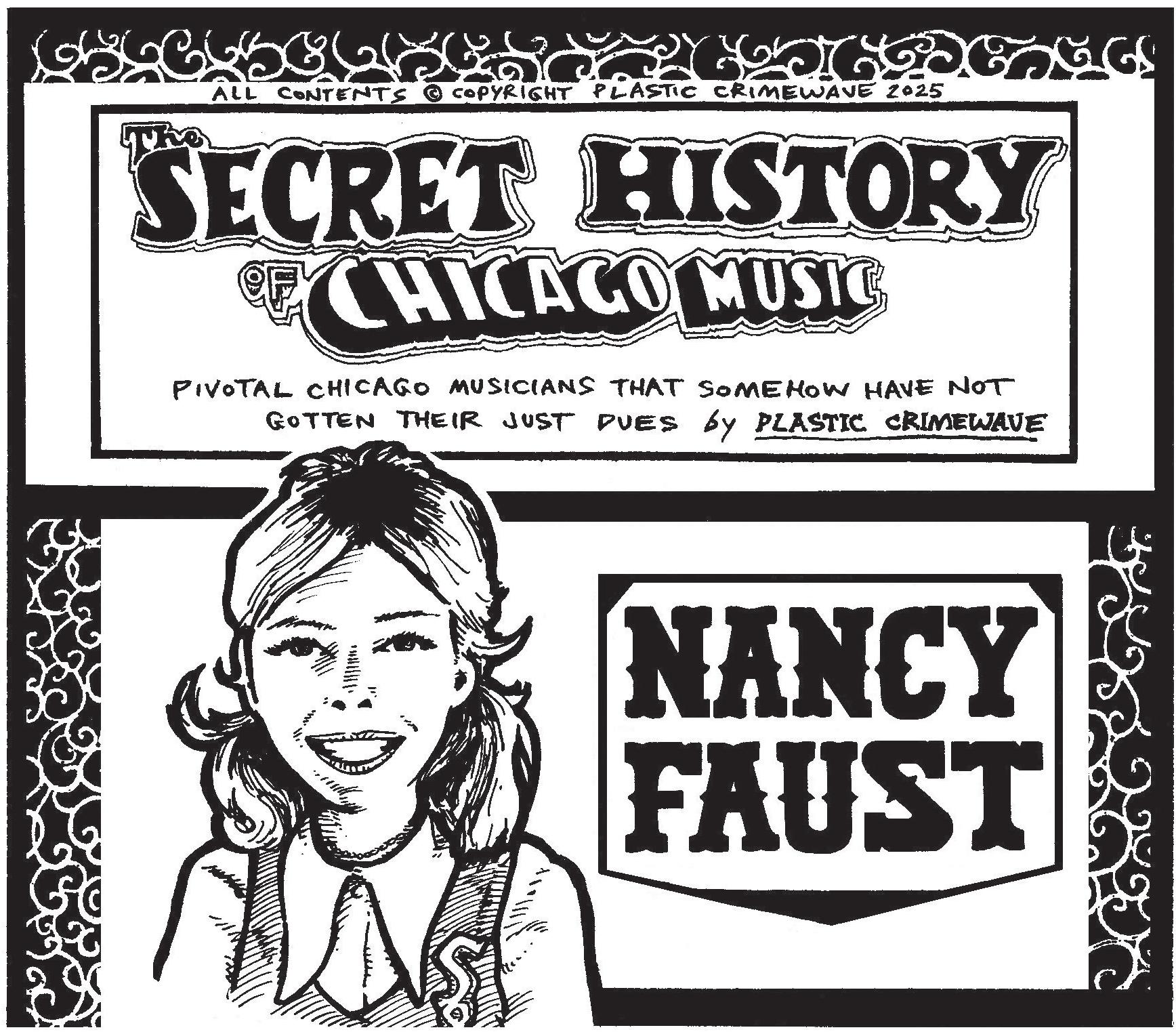
At that point, Faust wasn’t much of a baseball fan. In 1959, the Sox won their first pennant since 1919, and she didn’t even know. “When they set o the sirens in ’59, I was frightened,” she said in a mid-2000s interview with members of the White Sox Interactive (WSI) message board. “I called my cousin, and she told me what was going on. In fact my cousin was a big Sox fan and took me to my only game on her sixteenth birthday. I don’t know who they were playing, maybe Detroit or Cleveland, but she thought that Rocky Colavito was handsome, and she wanted to go to the game to see him.”
Stadium organs had existed for decades by that point. In 1941, Cubs owner Philip K. Wrigley became the first to install one in a baseball park, but the Wrigley Field organ lasted just two games and didn’t return till 1967. Ebbets Field, home to the Brooklyn Dodgers, installed an organ in 1942, and in 1960, White Sox owner Bill Veeck added one in the center-field stands of Comiskey Park. Faust was initially apprehensive about being among the unruly “bleacher bums,” and she kept her playing to a minimum. But she quickly won over the crowd. During a particularly good Sox season in 1972, Faust and announcer Harry Caray ramped up the showmanship. When she was hired, Faust had been asked to play the state song of each batter as he strolled to the plate, but she also had license to get more creative. In ’72, she debuted a customized version of
“Jesus Christ Superstar” for popular White Sox slugger Dick Allen.
Faust is widely credited with introducing this sort of personalized and often spontaneous “walk-up music” to Major League Baseball. Walk-up music was already a thing, popularized by Gladys Goodding at Ebbets Field, but Faust famously used it to o er witty, o -thecuff commentary on the game or take gentle pokes at opposing players. In the early 2000s, for instance, during a game against the Red Sox, she welcomed right fielder Trot Nixon with “Hail to the Chief” and “Would I Lie to You?”
“I really don’t know until I get to the games what names I’ll be hearing when they come to bat. Lately a couple of fans have been giving me a list of clever songs,” Faust said in the WSI interview. “I really don’t have any preparation. It comes to me when I’m there. If nothing comes to me right away, I might think of something or hear a good suggestion by the second or third at bat.”
Faust’s quick thinking and sense of humor
made her popular with fans. She credits Caray with encouraging her to commit to that style. Early in her career, she wore headphones to hear his radio commentary, and one day he said, “This game is going so slow, they are going to have to carry me out of here.” On impulse, she played a few bars of “Carry Me Back to Old Virginny.” Caray caught the joke and pointed it out to the crowd. “What kept me going,” Faust told the New York Times in 2010, “was I got such positive reinforcement from Harry and from the fans.”
Another anecdote turned up in the comments of a Facebook page called All Things Chicago: “Someone threw a blowup doll from the upper deck in right field,” the commenter said. “There was a collective gasp by the crowd for a second until we all realized what we were seeing. Then everyone, including the players, just busted out laughing. The doll floated to the ground, the right fielder picked it up and started dancing with it, and without missing a beat, Nancy started playing ‘Let Me Call You Sweetheart.’”
For the 1973 season, the Comiskey Park organ was relocated behind home plate. A few years later, Faust would chance upon another iconic innovation. In July 1977, while the Sox were on a hot streak, their batters got so many hits o a pitcher from the Kansas City Royals that he was pulled from the game. Faust sent the pitcher off with the chorus of the 1969 Steam hit “Na Na Hey Hey Kiss Him Goodbye.” She’d played it before, and fans knew it—the song had reached number one when it was new. But that was the day everything clicked and an enduring phenomenon was born. Sales of “Na Na Hey Hey” surged, and the label that had released it, Mercury, gave Faust a gold record later in ’77. Now you can hear the song at just about any team sporting event.
In the WSI interview with Faust, writer Hal Vickery claimed that she was “probably” the first to move past old-timey musical motifs
first album, 1978’s Nancy Faust at the Game (reissued last month), features live recordings from Comiskey and Chicago Stadium of “Rock Around the Clock,” “Bad, Bad Leroy Brown,” “Tie a Yellow Ribbon,” and more, plus of course “Na Na Hey Hey” and “Take Me Out to the Ball Game.” Her second LP, 1983’s Nancy Faust Presents Crowd Pleasing Favorites, includes the Steve Miller Band’s “Abracadabra” and Toto’s “Rosanna.” The rare cassette Nancy Faust’s Favorites came out shortly after the 1994 season and features some favorites of mine, among them Aliotta Haynes Jeremiah’s “Lake Shore Drive (L.S.D.),” Curtis Mayfield’s “It’s Alright,” and Mason Williams’s “Classical Gas.” I want copies of all of these, in case anyone’s holding!
In the 70s and 80s, Faust was in high demand. In 1975 she became the Chicago Bulls organist, playing a courtside keyboard. She kept that gig


ball team (1977 to ’81). She also played for outof-state teams: In the NHL, she worked around the Blackhawks schedule with the Minnesota North Stars (1987 to ’89), then did three games with the Phoenix Coyotes in 2008.
Faust stayed with the White Sox until 2010, missing fewer than ten games in all that time—to attend funerals and to give birth to her son, Eric, in 1983. (He would later take his first steps on the field at Comiskey.) When the Sox won the World Series in ’05, she got a ring too. She was invited to perform with the Chicago Symphony Orchestra that same year.
Beginning with the 2006 season, the White Sox had Faust perform only at daytime games. In 2009, she announced that she’d retire from the Sox the following year. On September 18, 2010, Faust was honored in a celebration at the second Comiskey Park (then U.S. Cellular Field) that included a pregame giveaway of ten
Cougars’ Night of 100 Promotions in 2011, then at additional Cougars games between 2012 and ’15. Since 2022, Faust has contributed organ to the podcast version of Countdown With Keith Olbermann. She also appears in the 2023 documentary Last Comiskey. This year Faust played for six Sunday games at what’s now Rate Field as part of the celebration of the 125th anniversary of the Chicago White Sox—returning to the organist’s booth that now bears her name. The first was on May 11 and the last on August 10. The team gave out commemorative bobbleheads at these games—Charles Comiskey, Ozzie Guillén, Luis Aparicio—but they didn’t include a reissue of the Faust bobblehead. So if you got one in 2010, hold onto it! It’s only gonna get more precious, because Faust is already an absolute legend. v





PICK OF THE WEEK
Funk-jazz explorer Gary Bartz brings his Ntu Troop to the Chicago Jazz Festival
Recommended and notable shows with critics’ insights for the week of August 28
b

Part of the Chicago Jazz Festival. Bartz performs at Jay Pritzker Pavilion, where the day’s lineup consists of the Ava Logan Quintet (4 PM), Ernest Dawkins Ensemble New Horizons Redux (5:05 PM), Gary Bartz & Ntu Troop (6:25 PM), and Kermit Ruffins & the Barbecue Swingers (7:45 PM). 6:25 PM (music begins at 11 AM), Millennium Park, 201 E. Randolph. F b
ARTISTS AT THIS YEAR’S Chicago Jazz Festival offer a range of approaches to the genre, including the sonic explorations of bassist and singer Esperanza Spalding and the traditional strains of trumpeter Kermit Ru ns. There’s a bit of big-band action, as well as reverential references to the music’s development in Chicago in the form of appearances by locals such as saxophonists Ernest Dawkins and Ari Brown. Before Ruffins’s headlining set on Saturday evening, a relentlessly creative troupe led by 84-year-old saxophonist Gary Bartz plays the main stage. Ntu Troop’s lineup includes trumpeter Theo Croker and drummer Kassa Overall, both born decades after the bandleader began his career, and though Bartz and his ensemble aren’t billed among this year’s headliners, they certainly could be.
During Bartz’s 1970s peak, he voiced a political perspective through his lyrics, as well as by merging Black popular musics and jazz—often with Ntu Troop, which he formed in 1969. Since 2001, he’s taught at the Oberlin Conservatory of Music in Ohio while continuing to release his own material. Among his recent projects is a 2021 entry in the Jazz Is
Dead catalog, for which he worked closely with the label’s cofounders, Ali Shaheed Muhammad of A Tribe Called Quest and producer Adrian Younge. They wrote all the material with Bartz, and they lean into its loping funk grooves, playing mostly bass and various keyboards as Bartz paints saxophone lines atop the rhythms.
In late September, Bartz, who has released more than 45 solo albums, will put out the new record Damage Control. He convened a new version of Ntu for the occasion, and the recording represents a retrenchment of purpose for the NEA Jazz Master. “Had they been the same age and in the same city at the same time, John Coltrane could have gone to school and graduated with James Brown,” says Bartz. “It’s really all the same music to me.” He proves that on “In Search of My Heart–Love Surrounds Us,” a slinky track where he uncorks narrative solos across an arrangement that would’ve suited Herbie Hancock’s Headhunters. Other o erings, such as “Fantasy” and “You Are My Starship,” recall 1970s CTI Records productions—pop tunes with the artistic gravitas of jazz music’s history. —DAVE CANTOR
ARC Music Festival day one See also Sat 8/30 and Sun 8/31. Music all day on four stages, headlined by Eric Prydz, Hot Since 82, Amelie Lens, and Skream b2b Hamdi (UK garage set). Other artists include Genesi, Cirez D (aka Eric Prydz), HAAi b2b Hiroko Yamamura, and Jamie XX. Complete daily lineups at arcmusicfestival.com; stage-by-stage set times at instagram.com/arcmusicfestival. 2–10 PM, Union Park, 1501 W. Randolph, single-day passes $179–$599.99, two-day passes $339–$1,099, VIP three-day passes $799.99, VIP+ three-day passes $1,549.99. 18+.
ARC Music Festival celebrates Chicago as the birthplace of house music, which has evolved into an unstoppable musical and cultural force around the globe. ARC debuted in 2021, and this year’s weekend-long lineup in Union Park includes legends, cult figures, and up-and-comers from near and far. The sprawling bill can speak to every generation and taste—you’ll have opportunities to explore novel sounds, whether you’re an old-school house head or a curious newbie just starting to dip your toes into the scene. Among the homegrown stalwarts performing are Cajmere (aka Curtis Jones , aka Green Velvet ), DJ Sneak , DJ Heather , Mike Dunn , Felix da Housecat , Honey Dijon , and Derrick Carter . You can see boundary-pushing techno artists who cut their teeth in Detroit’s techno scene, such as Carl Craig and Richie Hawtin, plus plenty of heavy hitters from further afield, including New York–based duo Duck Sauce (aka A-Trak and Armand van Helden) and Swedish tech-house DJ Eric Prydz (who also plays here as Cirez D). ARC is equally compelling as a showcase for rising names, including South African house producer Desiree (in a back-to-back or “b2b” set with Paris DJ Chloé Caillet ), Italian melodic techno DJ Genesi , and jazz– and hip-hop–inspired Anaheim DJ Ayybo (aka Aaron Bonnema). The weekend features many b2b sets, and it’s always fun to hear talented DJs bouncing ideas off each other. Some of these sets bring together longtime friends to express their rapport in grooves (Honey Dijon and Derrick Carter on Sunday should be a thrill), while others pair local artists with talent from abroad. On Friday, storied Chicago second-waver Hiroko Yamamura plays with


Australian techno producer HAAi, and on Saturday, house legend Green Velvet hits the decks alongside British-born Nigerian DJ Skepta. In case three days and nights of dancing in Union Park aren’t enough, ARC also hosts a whopping 33 preparties, a erparties, and other events (among them a brunch, an outdoor pop-up, and a couple cruises) that run from Thu 8/28 through Mon 9/1. Venues include Metro and Smart Bar, Masada, Outset, Spybar, Radius, and Castaways on North Avenue Beach.
—JAMIE LUDWIG
Bleary Eyed Daundry and Yours, Mookie open. 8 PM, Schubas, 3159 N. Southport, $20.25. 18+
Philadelphia has quite a collection of young shoegaze bands, and I admire how experimental some of them get. Until I heard They Are Gutting a Body of Water, for instance, I never knew that shoegaze’s amniotic bath of electric guitar could make room for the speed-freak percussion of breakcore. That’s not to say I don’t also appreciate it when one of these adventurous groups goes for a more classic sound, though. Philly band Bleary Eyed have smoothed out some of the odd angles on their 2021 album Guise (glitchy song structures, martial percussion, squealing synth breakdowns) en route to re-emerging with their next full-length, the new Easy. They still use electronic or programmed elements extensively, but this time they provide build-

ing blocks within a traditional shoegaze aesthetic. Lead track “Susan” glistens with slow-motion whammy- bar swoops, and bustling looped drums shape its radiant haze of noise like a corset. You can hear aspects of trip-hop and 80s UK goth music, but Bleary Eyed use them as though they’ve always been part of shoegaze and might always be. Future generations could do a lot worse than to look back on Easy to help define shoegaze in its next incarnation. —LEOR GALIL
Ari Brown, Joshua Abrams, and Mike Reed See also Sat 8/30. 8:30 PM, Constellation, 3111 N. Western, $25.91. 18+
The Chicago Jazz Festival doesn’t end when Millennium Park goes quiet. Clubs around the city put on special a erfest shows, some of them more exciting than the main-stage sets. This trio—tenor saxophonist and pianist Ari Brown, bassist Joshua Abrams, and drummer Mike Reed—continues a tradition that originated at the Velvet Lounge, the club owned by tenor giant Fred Anderson. The Velvet hosted afterfest jam sessions that included members of the Association for the Advancement of Creative Musicians (AACM) and out-of-town guests such as Kidd Jordan. A er Anderson died in 2010 and the Velvet Lounge shut down, Constellation (owned by Reed) picked up the torch. From year to year, the a erfest programming at Constellation has varied in personnel and practices, and this trio is bound to stir up a few old memories while making new ones. The 81-year-old Brown belongs to a cohort of musicians that also includes Joseph Jarman, Roscoe Mitchell, and Henry Threadgill, all of whom studied at Woodrow Wilson Junior College (now Kennedy-King) in the 1960s and went on to join the AACM. Brown’s tonal warmth and stylistic flexibility enabled him to sound equally apropos playing electric jazz with local combo the Awakening, blowing volcanic postbop with drummer Elvin Jones, and exploring avant-garde angles with percussionist Kahil El’Zabar. His solo recordings (released on Delmark) have emphasized his connections to Chicago’s hard-bop tradition, but he has also forged a strong connection with Abrams, whose best-known project is the trance-inducing Natural Information Society. In 2022 they connected with Reed and began playing periodic concerts, which have opened the door to a late-career resurgence of creativity for Brown. The trio’s completely improvised sets (to date not





Since 1975, the Rink has been much more than a place to throw on your skates; it’s a haven for community, movement, and music. Not only do they embrace traditional Chicago-style skating and culture, but the Rink is also ensuring that it is passed down to the next generation of skaters.
When speaking with Ramona Pouncy, who owns the Rink with her husband, Curtis, she stated pridefully, “The Rink saves lives.” About six years ago, right before the onset of the COVID-19 pandemic, the couple saved The Rink and the property it sits on from being redeveloped into a trucking company. Although the two were set to retire, they knew The Rink was too essential to lose, and having skated at the Rink’s first location on 89th Street as a young girl, Ramona was set on restoring its nostalgic excellence.

While The Rink continues to host open skate nights for all ages and all skill levels, there is an emphasis on supporting the south side’s youth. For many years to come, The Rink intends to remain a staple, accessible resource, and safe outlet for teens to spend their time.
The Rink is much more than a venue and space for bodily expression; the team serves as mentors to everyone who comes through their doors. In addition to offering traditional roller rink snacks and drinks, your usual candy, soda, and chips, The Rink seeks to provide a healthy balance with cold-pressed juices and nutritious meals. The education the Rink provides goes beyond their skating lessons, extending to everything they do. Their holistic approach to wellness and mindfulness of the mind–body connection is passionately rooted in improving the community’s quality of life.
As the last Black-owned roller rink in Illinois, the Pouncys are keenly aware of the legacy they are tending to and keeping alive. Taking over The Rink has led to a deepened connection to the community; it’s led to reciprocal partnerships that sustain and nurture the entire ecosystem.
THE RINK
1122 E. 87th Street
In June, the Rink celebrated a big milestone: 50 years of skating excellence. Whether you roll around with speed or like to saunter nice and slow, skating at the Rink has been, and always will be, a boundless bonding experience.


Find more music listings at chicagoreader.com/musicreviews

continued from p. 19
captured on an album) range freely between smoldering blues, energized free jazz, and in-depth explorations of rhythmic abstraction. Brown goes further out than he does in any other context, but he always brings the music back for a deeply satisfying resolution. At press time, no other musicians have been confirmed for these two shows, but the trio doesn’t really need to jam with anyone else; there’s no better band in Chicago right now. —BILL MEYER
ARC Music Festival day two See Fri 8/29. Music all day on four stages, headlined by Fisher, Paca Osuna b2b Ilario Alicante, Green Velvet b2b Skepta Más Tiempo, and Richie Hawtin. Other artists include Cajmere b2b Carl Craig, Eris Drew b2b Octo Octa, DJ Sneak b2b DJ Heather, and Claude Vonstroke. Complete daily lineups at arcmusicfestival.com; stage-by-stage set times at instagram.com/arcmusicfestival. 2–10 PM, Union Park, 1501 W. Randolph, single-day passes $179–$599.99, two-day passes $339–$1,099, VIP three-day passes $799.99, VIP+ three-day passes $1,549.99. 18+
Gary Bartz & Ntu Troop See Pick of the Week on page 18. Part of the Chicago Jazz Festival. Bartz performs at Jay Pritzker Pavilion, where the day’s lineup consists of the Ava Logan Quintet (4 PM), Ernest Dawkins Ensemble New Horizons Redux (5:05 PM), Gary Bartz & Ntu Troop (6:25 PM), and Kermit Ruffins & the Barbecue Swingers (7:45 PM). 6:25 PM (music begins at 11 AM), Millennium Park, 201 E. Randolph. F b
Ari Brown, Joshua Abrams, and Mike Reed See Fri 8/29. 8:30 PM, Constellation, 3111 N. Western, $25.91. 18+
by John Summit, Duck Sauce, Honey Dijon b2b Derrick Carter, and Alignment. Other artists include Felix da Housecat b2b Mike Dunn, Chloé Caillet b2b Desiree, Luciano b2b Ricardo Villalobos, Ayybo, and Eli Brown. Complete daily lineups at arcmusicfestival.com; stage-by-stage set times at instagram.com/arcmusicfestival. 2–10 PM, Union Park, 1501 W. Randolph, singleday passes $179–$599.99, two-day passes $339–$1,099, VIP three-day passes $799.99, VIP+ threeday passes $1,549.99. 18+.
The Extra Shift Show Featuring Intellect RFG, Brax10, iGoByLC, Kyn, F.B.E., and DJ Peach. 6 PM, Bookclub, 2871 N. Lincoln, $20, $15 in advance. 21+
The Extra Shift Show brings together a lineup of up-and-coming local rappers operating in a diversity of styles. These days this sort of showcase is unfortunately sporadic in north-side clubs, despite the events curated by Chicago multimedia outlet Real Ones. I hope the Extra Shift Show leads to more variety in grassroots hip-hop programming, and the venue might be a good omen: Bookclub occupies the former Elbo Room space, and Elbo Room hosted one of Chicago’s most important regular hip-hop parties, Blue Groove Lounge. Tonight’s bill features five MCs plus DJ Peach on the turntables. F.B.E. raps in a throaty murmur over dreamy arrangements, and on the 2023 single “Whatever” he adopts a tumbling triplet flow. Kyn moves back and forth between blown-out party tracks (“FreakNik,” “Kyn Shxt”) and sultry R&B-flavored numbers (“Love Doctor”) with a cool air and sharp focus. IGoByLC drops bars with a heavy swing over jazzy instrumentals that deliver a serious kick. Brax10’s smooth, Auto-Tuned verses coast over gently undulating melodies punctuated by electronic hi-hats. Intellect RFG can bend any rap style to match his sunny disposition—on March’s self-released Four SZN’s, he gets almost singsong for the lovey-dovey standout “Be Mine.” —LEOR GALIL


Monday 7-10; Tuesday and Thursday 10 AM-2 PM, 8 PM-midnight; Wednesday 6-10 PM; Friday 7-11 PM; Saturday 10:30 AM-3 PM; Sunday 1 PM-1:30 AM rinkchicago.com | @therinkchicago | 773-221-2600 Read now
ARC MUsic Festival day three See Fri 8/29. Music all day on four stages, headlined
Ar-Kaics Miniskirt and HoZac Sadistic Sound System open. 9 PM, Empty Bottle, 1035 N. Western, 21+. F
Virginia four-piece the Ar-Kaics formed in 2012, and their members have played together since the 90s—but as their name suggests, they sound much older. Their first two albums—2014’s The Ar-Kaics and 2018’s In This Time, the latter on Daptone rock imprint Wick—capture the fun, high-energy swagger of classic American garage rock. With their hooky songwriting and spot-on vintage-sounding production, they’d fit right in among the late-60s bands documented on the famous Nuggets compilation. The Ar-Kaics took six years to arrive at their next full-length, 2024’s See the World on Fire (Feel It), and it takes a somber turn—their sound is still very
60s, but it leans more toward the deep psychedelia and forlorn folk rock at the end of the decade. Album opener “Chains” seems to lament the voluntary bondage of tradition, and it’s moody and heavy enough to border on proto-metal. Thankfully the Ar-Kaics include some upbeat songs too: The rollicking, gold-flecked anthem “Stone Love” sounds triumphant, despite its embittered lyrics about a broken romance. That band extend that momentum on “Cornerstone,” whose earthy hook is so catchy that I woke up with it in my head for days. This Empty Bottle show is the Ar-Kaics’ Chicago debut.
—JAMIE LUDWIG v













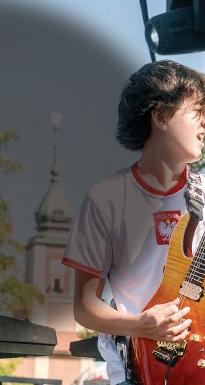

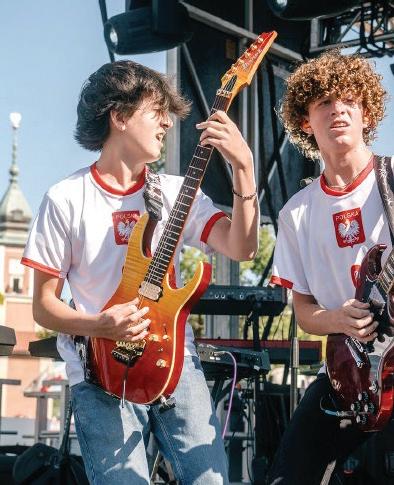



CYBERGRIND IS A difficult genre to define, but Gossip Wolf hears its spirit loud and clear in Blind Equation , a heavy- electronics project founded by Chicagoan James McHenry . Blind Equation’s second album, 2023’s Death Awaits, arguably set the template for this small but mighty underground scene: brittle chiptune synths race through complex, inventive arrangements, battered by tornadic drumming and scoured by screamo caterwauling. When McHenry started writing the next Blind Equation album, though, Death Awaits haunted him—it had worked so well that he had to tear himself free of its aesthetic gravity. He looked for a way to make a radical change.
“A lot of songs were scrapped, just because I felt like I needed to do something new for the sake of my own creativity,” McHenry says. “One thing that I needed to do was completely change the synths that I was using for Blind Equation and completely start off on a new palette— start from scratch.” The group’s third full-length, A Funeral in Purgatory , came out last month, and McHenry built its palette using Vital , a free virtual synthesizer with an extensive library of sounds as well as digital tools that make it easy to reshape waveforms. “The main goal of this album was to make it sound massive and expansive,” he says.
A furry ear to the ground of the local music scene
new-sounding band, despite having the same exact setup and same exact lineup.”
Blind Equation celebrate A Funeral in Purgatory by headlining Subterranean on Sunday, August 31. Opening the show are Soulkeeper, Rakuyo, and glitchy, quasi-industrial

contributes violin to A Raucous Display) open the show. Doors are at 6 PM, and the show starts at 7 PM. Attendees are encouraged to donate $10.
IN THE 2000S, Chicagoan Jason Frederick performed and recorded as Love Story in Blood Red a er the breakup of his band the Means. LSiBR’s scab-kneed rock ’n’ roll love songs impressed Reader critic Monica Kendrick, who in 2006 wrote that Frederick was “bitter in a literary and passionate way, and his vocals are stretched across a framework of spindly but grand and gritty rock.” The project has been dormant for almost a generation, but LSiBR will play their first show in 18 years on Friday, August 29, at Montrose Saloon. Frederick got the band back together in part to celebrate a forthcoming LSiBR compilation, Everything’s Everywhere, released as a double LP by New York indie label Goodtimes Rock-n-Roll Club . The show also features sets by French Casino , Nad Navillus (as a duo), and Another VU. Tickets are $15, and the first band starts at 8 PM.

McHenry sought out a range of inspirations for A Funeral in Purgatory, including gloomy black metal, the cybernetic industrial crunch of the 2023 Health album Rat Wars , and the featherweight cloud rap of the 2020 Bladee release 333 . “I really love Whitearmor’s production on that [Bladee] album,” he says. “I’m always interested in finding ways to re-create pop music that I love—or rap music, or genres completely outside of metal—but make that [into] metal, and make it work, and not make it sound corny.”
McHenry also needed to adapt Blind Equation’s new sound to the stage. In concert, he’s backed by drummer Bill Kaszubowski and keytarist Jeffrey Kornfeld , and together they’ve retooled Blind Equation’s older material to fit the sound of A Funeral in Purgatory . “Jeff is now using different mikes and patches to match the synths on the new album—he has a lot more bell sounds to emulate that black-metal chime thing that goes on throughout the album,” McHenry says. “Even when we’ve been playing old songs, we’re a
local cybergrind group Hot Lettuce! , one of the new acts that have made Chicago a hotbed for the style. “It’s cool that there’s so many more artists doing cybergrind or something that’s adjacent enough to cybergrind to where they fi t in on a bill,” McHenry says. “Chicago has a thriving experimental music scene, whether it’s in hyperpop, noise, extreme music, or cybergrind.” Tickets cost $21.80, and the music starts at 8:30 PM.
GOSSIP WOLF HAS caught wind of a new local posthardcore band, Laliberté , fronted by former Ira Glass guitarist Sunny Betz Laliberté started in May, and Betz, drummer Lamb Buttons , bassist Shaye Rosengarden , and lead guitarist Matthew Hocutt have already put together enough material to fill an EP. The band will self-release the delightfully gnarly A Raucous Display of Ineptitude on Saturday, August 30. That night they’ll headline a release show at Esquina (4602 N. Western), a community arts space that shares an owner with Nomadic Ant, the jewelry shop next door. Laliberté will be selling cassette copies of the EP as well as a zine by Rosengarden called Auricle. IDM artist Oipeee! and Fruitleather songwriter D Jean-Baptiste (who
IN JULY, SOUTH-SIDE postpunk band Fantasma Negra self-released their debut EP, the bone-chilling L.U.S.T. To celebrate, they’ll play at the dream-pop minifest Unsummer , which takes place on both of Subterranean’s stages on Saturday, August 30. It brings together a crowd of bands whose music likewise feels like a blast of arctic air. Darkso , Cool Heat , and Heels play downstairs; Fantasma Negra headline upstairs, with openers Carrellee , Velvet Wounds , and Nothing but Silence . Advance tickets are $33.14 ($21.80 for a single bill), and both shows kick off at 7:30 PM.
GOSSIP WOLF IS always looking for interesting new ways to hear music with fellow Chicago fanatics. That makes Ambient Chess pretty irresistible! This periodic event offers the chance to play a casual game of chess (bring your own board) to a soundtrack of adventurous, trance-inducing electronic music. Ambient Chess is currently helmed by DJ duo Kissparcht (aka Megha Bamola and Plight Jada ), and their next night will take over the front bar at Sleeping Village on Thursday, August 28. Guest DJs Chelliah and Rik will join Kissparcht; it’s free and starts at 7 PM. —LEOR GALIL Got a tip? Email your Chicago music news to

Attorney, Corporate (Chicago, IL) Represent publ.- &priv.-held co’s, as well as PE sponsors &their portfolio co’s, in conn. w/ transactions which incl. international acquisitions, strategic mergers, takeprivate transact., equity investments. Advise clients consider. or particip. in transact, incl. advising on transact. structures &deal terms. Negot. &prep. primary transact. docs. $260,000 per year.
Req’mts: JD or foreign equiv., IL Bar, 2 yrs of exp. in position or 2 yrs. of alternate occupational exp. performing complex crossborder merger &acquisition advisory legal duties. Email resume/ref’s to Shadae.Pickett@lw.com, referencing position ACO1. Latham &Watkins LLP.
Attorney, White Collar Investigations (Chicago, IL) Represent public &private corps. &their officers &directors in gov’tal &internal investigations. Advise clients on compliancerelated issues, incl. in transactional contexts. Oversee doc review &production. Prepare for &conduct witness interviews. Develop case strategies. Prepare investigative reports, talking points, presentations, corresp. w/ regulators &internal stakeholders. Represent clients at interviews, depositions, trial. Negotiate resolutions &prepare assoc. docs. $260,000 per year. Req’mts: JD or foreign equiv., IL Bar, 2 yrs of exp. in position or 2 yrs. of alternate occupational exp. performing complex corporate regulatory defense advisory legal duties. Email resume/ ref’s to Shadae.Pickett@ lw.com, referencing position AWCI2. Latham &Watkins LLP.
Auditor and Tax Accountant in Glenview IL. Must have Master Degree in Accounting. Prepare &file federal, state &local tax returns for individuals, partnerships, non-profits &corporations in compliance w/
applicable tax laws and regulations. Conduct detailed audits of financial statements, ensuring accuracy &compliance w/ Generally Accepted Accounting Principles (GAAP) &relevant regulations. Analyze financial records, systems &transactions to identify discrepancies, trends or areas of risk.Maintain detailed records &stay updated on changes in tax regulations. Communicate w/ clients to clarify information &address questions or concerns. Assist in preparing audit reports w/ findings, recommendations &supporting documentation. Perform periodic reviews of clients’ internal control systems to identify areas for improvement. Send resume to: Lin &Lincoln CPA’s, LLC, 1132 Waukegan Rd Suite 101, Glenview IL 60025.
Chicago Methodist Senior Services seeks Director of Contracts &Compliance (Chicago, IL). Identify legal requirements ®s under Philippine law affecting Filipino healthcare workers’ coming to U.S. to work. Reqs. Bachelor’s (or foreign equiv.) in law, legal studies, or closely rltd field. Must have knowledge of rules ®s governing Philippines Dept. of Migrant Workers’ (f/k/a Philippine Overseas Employment Admin.) involvement in recruiting &employing Filipino healthcare workers overseas. May telecommute 1 day/week. Pay: $86,819/yr. Visit www.cmsschicago.org/ careers to apply &see info on role, pay &benefits.
Clinic Operations DirectorChicago IL. Must have MBA, 4 yrs of mgmt exp. in med/health ind.+10 yrs of general exp. in med/ health ind. Oversee daily clinic ops, ensure smooth patient flow &optimal resource use. Dev/impl opnl protocols to enhance efficiency &serv. quality. Collaborate w/ medical pros to ensure seamless exp. for patients. Monitor/ optimize appt scheduling, tx processes &followup care. Lead, train, &manage team at clinic. Foster positive &prod work environ. that aligns w/ Co. mission &values. Conduct perf evaluations &provide continuous pro dev opportunities. Manage clinic’s budgets, optimize opnl costs, &ensure financial targets are met. Track KPIs &impl

strategies to improve rev &profitability. Collaborate w/ finance team to oversee billing, &expense mgmt. Ensure adherence to all established GLs ®s. Maintain high standards of patient safety, ðical practices. Impl &oversee QA programs to enhance patient outcomes &satisfaction. Enhance patient journey by impl best practices in CS &care. Address patient concerns, manage feedback, &continuously improve serv. delivery. Ensure welcoming &pro environ. for all patients &visitors. Work closely w/ mktg team to attract new patients &expand clinic’s presence. Identify &dev partnerships w/ local salons, wellness centers, &med pros. Support expansion of clinic serv., incl. new tx &intl collaborations. Send resume to: Kafuring Mgmt USA LLC DBA Intl Hair Institute, 50 E Washington St #200, Chicago, IL 60602.
Emergency Department Physician (Chicago, IL), Responsible for assessing &stabilizing patients in the emergency room by treating injuries, infections, &other urgent conditions. Duties incl ordering tests, developing treatment plans, performing followups, &coordinating discharges or referrals to specialists as needed. Reqmnts: Doctorate of Osteopathic Medicine, 72 mnths of exp, Residency in Emergency Medicine, &Medical License for the state of IL. Sal $239,200/ Yr. Send resume to Saint Anthony Hospital, 2875 W. 19th St., Chicago, IL 60623
Engineer, Technology II - Data Solutions, AbbVie Inc., Mettawa, IL: Develop data solutions aimed to enable precision marketing to HCP’s (healthcare practitioners/ professionals). Work w/ brand representatives, marketers, data scientists &omni-channel strategists to gather requirements &develop cloud-based solutions of integrated data sets &visualizations to help AbbVie more effectively engage w/ HCP targets. Work directly in Digital Brand Teams as a critical team member responsible for all data engineering &data science model operationalization. Must have a Bachelor’s in engineering, computer science, physics, mathematics, or quantitative life sciences, or related field and 5 years of work experience as a
data engineer, systems engineer, or similar role in a commercial biopharma environment with each of the following: (i) Extracting and combining multiple internal and external data sets; (ii) Onboarding, consolidating, cleansing, and structuring data for efficient use in reports, analytical applications, and machine learning models; (iii)_Pressuretesting data requirements to ensure accurate and meaningful data delivery; (iv) Performing data analysis and reconciliation on datasets of varying sizes and complexities; (v) Compiling, presenting and explaining data to business stakeholders; and (vi) utilizing data analysis programming languages (e.g., SQL, Python, R, and Spark). Alternatively, would accept Master’s in engineering, computer science, physics, mathematics, or quantitative life sciences, or related field and 2 years of work experience as a data engineer, systems engineer, or similar role in a commercial biopharma environment with each of the following: (i) Extracting and combining multiple internal and external data sets; (ii) Onboarding, consolidating, cleansing, and structuring data for efficient use in reports, analytical applications, and machine learning models; (ii) Pressuretesting data requirements to ensure accurate and meaningful data delivery; (iii) Performing data analysis and reconciliation on datasets of varying sizes and complexities; (iv) Compiling, presenting and explaining data to business stakeholders; and (v) Utilizing data analysis programming languages (e.g., SQL, Python, R, and Spark). Experience may be gained concurrently.
Salary Range: $147,472$157,500 per year Apply online at https://careers. abbvie.com/en or send resume to Job.opportunity. abbvie@abbvie.com. Refer to Req ID: REF43019S.
Health Care Service Corporation seeks Sr Test Engineers (Chicago, IL) to dvlp frmwrks for test scripting, automation &troubleshooting. REQS: Bach 4 yrs exp. Flex role (3 dys in office / 2 dys remote) Pay: $104,728 - $149,300/yr. Benefits: https://careers.hcsc. com/totalrewards. Email resume to hrciapp @bcbsil.com, ref R0044746

Morningstar, Inc. seeks a Product Specialist (multiple positions) in Chicago, IL to act as both product experts and strategists to translate market trends, customer needs, competitive intelligence, and Morningstar intellectual property into innovative deliverables that solve customer and market problems, and evangelize those innovations internally and externally (10%). BS in comp sci, comp engg, or closely rltd engg field &2 yrs of exp in product management, business analysis, or software development roles req’d. Add’l specific skills req’d. Base salary: $72,779-$88,200/year. For position details &to apply, visit: https://www. morningstar.com/careers; ref. job ID REQ-052064.
Northwestern Memorial HealthCare seeks Senior Data Scientist in Chicago, IL to build models by executing predefined experiments and templated code within the standard model development paradigm. MS in machine learning, comp sci, engineering, math, physics, or a rltd field &5 yrs of rlvnt experience with machine learning, a focus on model building, and analysis of outcomes and model deployment in Data Scientist- Innovation, Graduate Assistant, or a rltd position req’d. In alt, a PhD in machine learning, comp sci, engineering, math, physics, or a rltd field plus 3 yrs of rlvnt experience with machine learning, a focus on model building, and analysis of outcomes and model deployment in Data Scientist- Innovation, Graduate Assistant, or a rltd position req’d. Remote work requests considered consistent with our remote work policy. Salary range: $99,174.4 - $165,981.375/yr. For position details &to apply, visit: www.jobs.nm.org.
Restaurant Manager (Chicago, IL) Plan, direct, &coord activities of a Mediterranean restaurant. Monitor food &eqpmt inventories. Check delivery contents. Monitor compliance w/ health &fire regs. Sched staff hrs &assign duties. Organize &direct worker training prgms, resolve personnel problems, &evaluate employee performance. Bachelor’s Deg is reqd. 40 hrs/wk. Send resume to Ertugrul Akova, Owner, Konak Inc, konakchicago@ gmail.com.
Senior Project Manager position at BIG Construction, LLC. Position located in Chicago, IL. Responsible for overseeing and coordinating successful completion of single or multiple construction projects. Salary: $132,500. Benefits: Comprehensive
health, PTO, 401k. Position requires Bachelor’s degree in Constr. Mgmt, Mech. Eng. or rltd field (or foreign equiv) &4 yrs. relevant exp. Position requires up to 20% of time traveling locally to project sites in the Chicagoland area and allows for telecommuting within commuting distance of reporting office in Chicago, IL. Apply via the company website: https:// www.buildbig.com/jobs/ senior-project-manager
Senior SQL Business Intelligence Developer, Chicago, IL, for Team TAG Services, LLC (TAG). Responsible for managing the definition, design, &development of reporting/ dashboard for Aspen Dental Management Inc. Responsible for data integration from internal &external source systems into the Enterprise Data Warehouse (EDW). Req’d: Bachelor’s in Computer Science, Information Technology, or a closely related field &5 yrs’ exp. in Business Intelligence OR Master’s in Computer Science, Information Technology, or a closely related field &3 yrs’ exp. in Business Intelligence. May work remotely up to 2 days/wk. Salary: $153,650/ yr. A generous benefits package that includes paid time off, health, dental, vision, &401(k) savings plan with match. Resumes to code SM-SBID, c/o Juliana Ximenes, TAG, 800 W Fulton Market (juliana. ximenescoutinhodias@ teamtag.com).
Software Engineer in Chicago IL. Must have Master Degree in Computer Science. Develop efficient algorithms for course recommendations, adaptive learning paths, &content retrieval. Implement AI-powered solutions such as intelligent search, personalized course recommendations &predictive analytics to improve user engagement. Utilize clustering, classification &association rule discovery techniques to enhance data analytics &reporting. Work on both front-end (JavaScript, HTML, CSS, Telerik UI) &back-end (VB.NET, ASP.NET, SQL Server) components. Ensure high system reliability, performance tuning &database optimization. Participate in technical design discussions, troubleshoot issues &propose innovative solutions. Send resume to: 360Factor Consulting, LLC, 1252 W Monroe St, Chicago IL 60607.
Valkyrie Trading, LLC seeks Senior Software Engineer in Chicago, IL to conceptualize and author the technologies that power trading activities in financial markets. $200,000 to $225,000/yr. Apply @ www.jobpostingtoday. com/ Ref #39733

NOTICE OF PUBLIC SALE: The following selfstorage units contents containing household and other goods will be sold for cards by Chicago Northside StorageLakeview at 2946 N Western Ave, Chicago, IL 60618 to satisfy a lien on September 15th, 2025, at 2:00 pm at www. storagetreasures.com
CC72 Stan Bartkus C03 Unok Baccia C16 Unok Baccia C36 Andy Nevarro C57 Herbert Hickerson Jr E12 Nualanong Leeamnuaycharoen G09
Nelly P Weiss O04 Andy Nevarro O10 Andy Nevarro O11 Andy Nevarro O28 Andy Nevarro P49 James Dorsey R13 Andy Nevarro T009 kimberley morris T096 Andy Nevarro T107 Andy Nevarro Chicago Northside Storage

CHESTNUT
ORGANIZING AND CLEANING SERVICES: especially for people who need an organizing service because of depression, elderly, physical or mental challenges or other causes for your home’s clutter, disorganization, dysfunction, etc. We can organize for the downsizing of your current possessions to more easily move into a smaller home. With your help, we can help to organize your move. We can organize and clean for the deceased in lieu of having the bereaved needing to do the preparation to sell or rent the deceased’s home. We are absolutely not judgmental; we’ve seen and done “worse” than your job assignment. With your help, can we please help you? Chestnut Cleaning Service: 312-332-5575. www.ChestnutCleaning. com www. ChestnutCleaning.com























